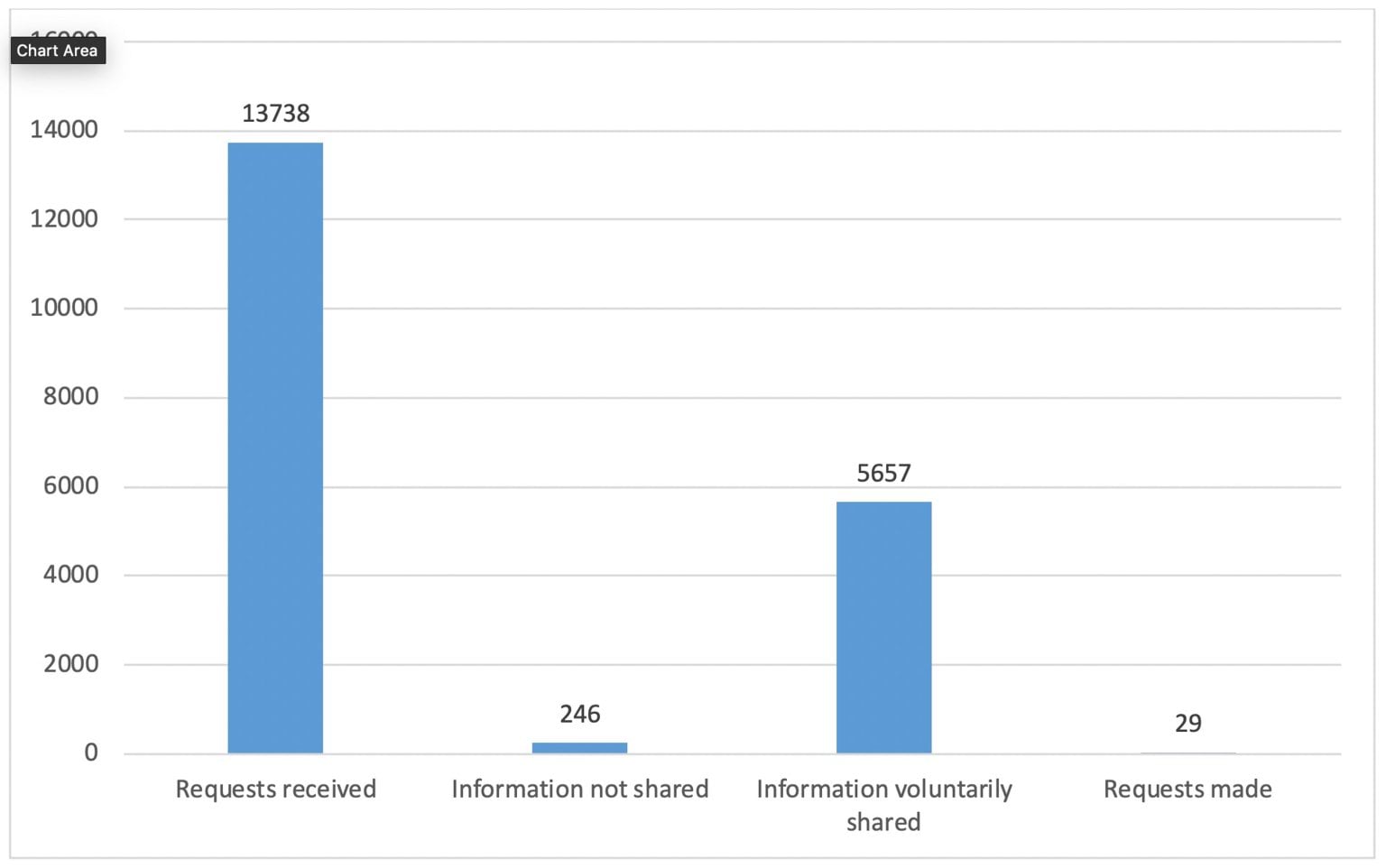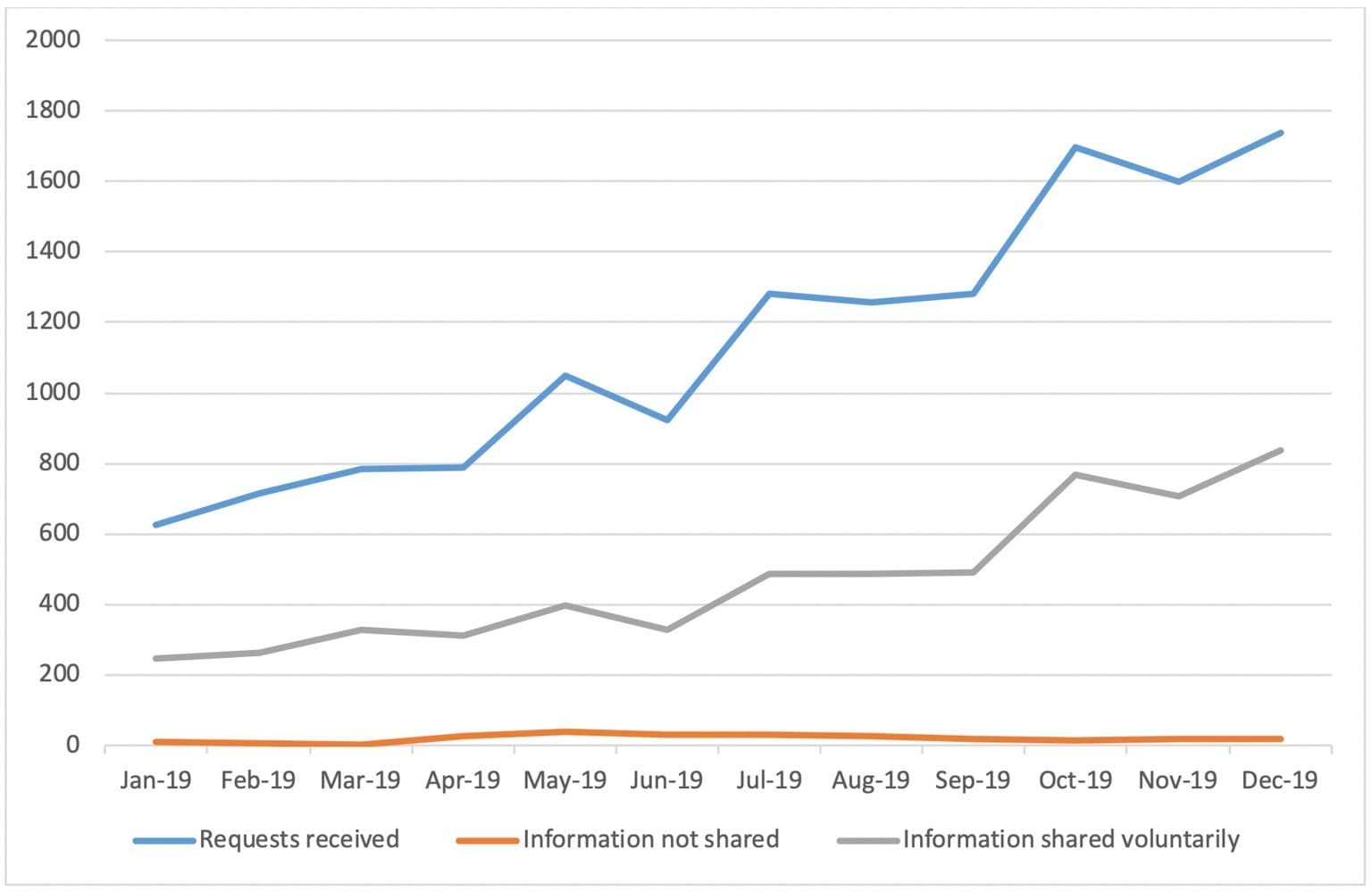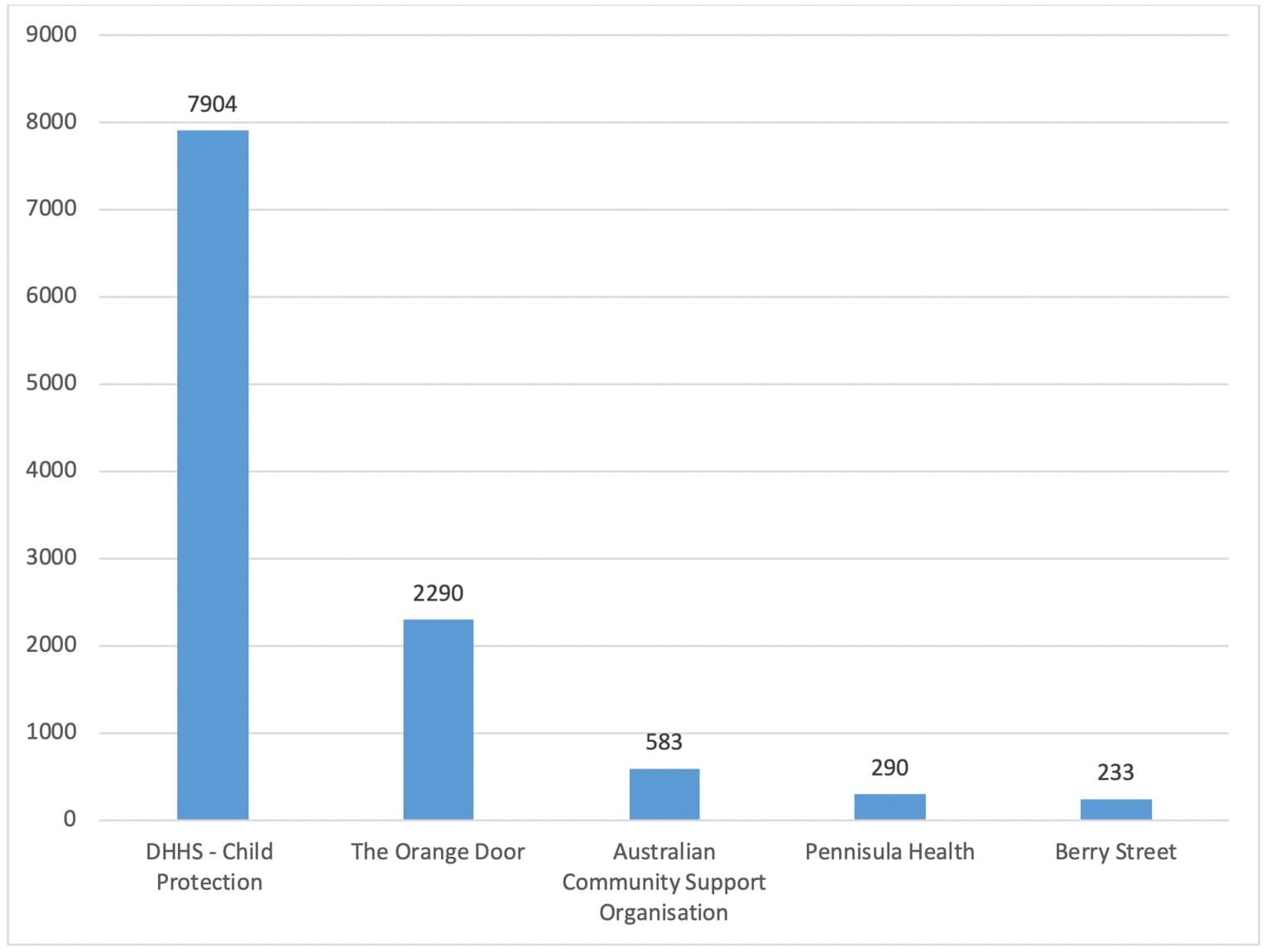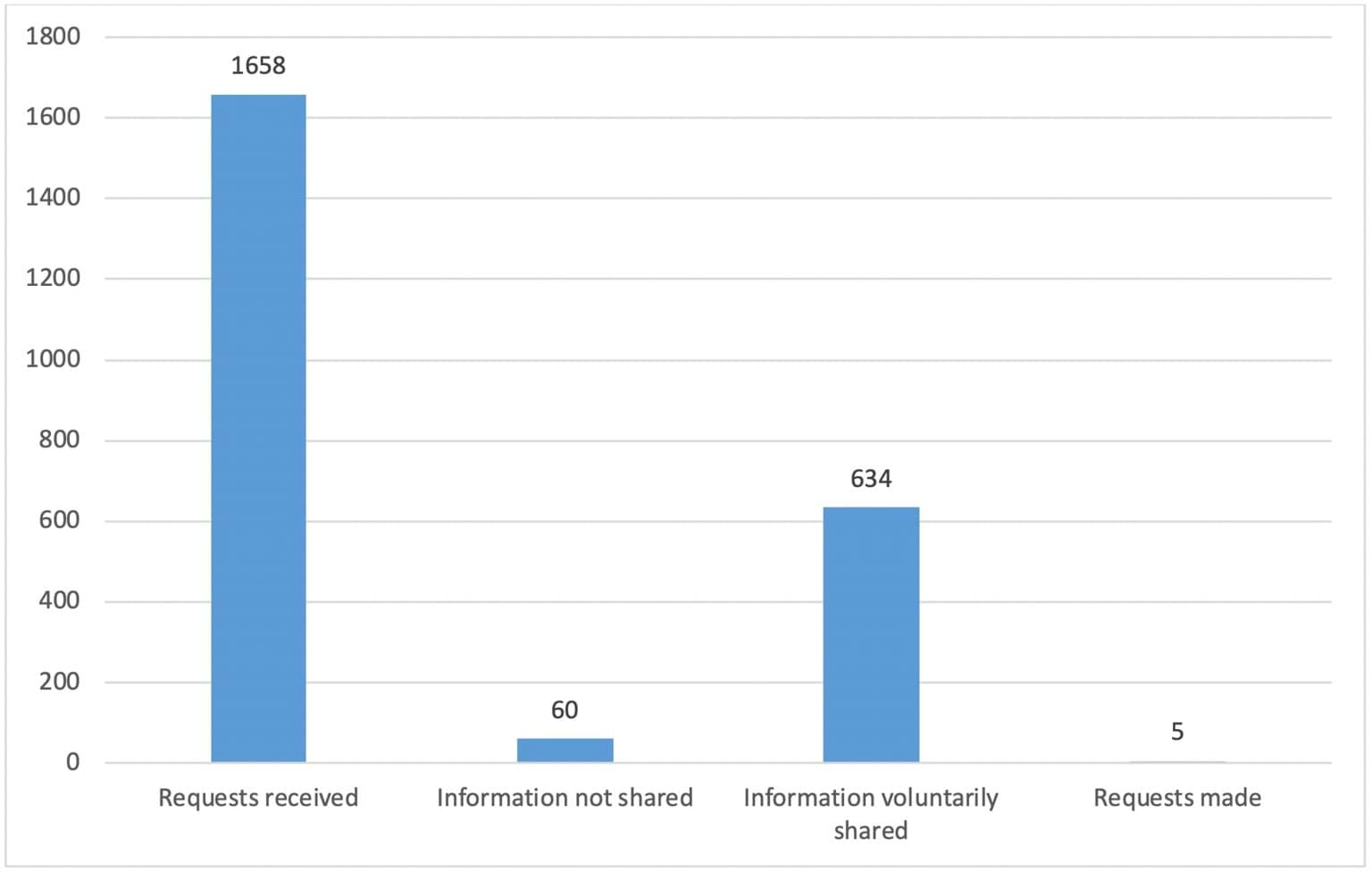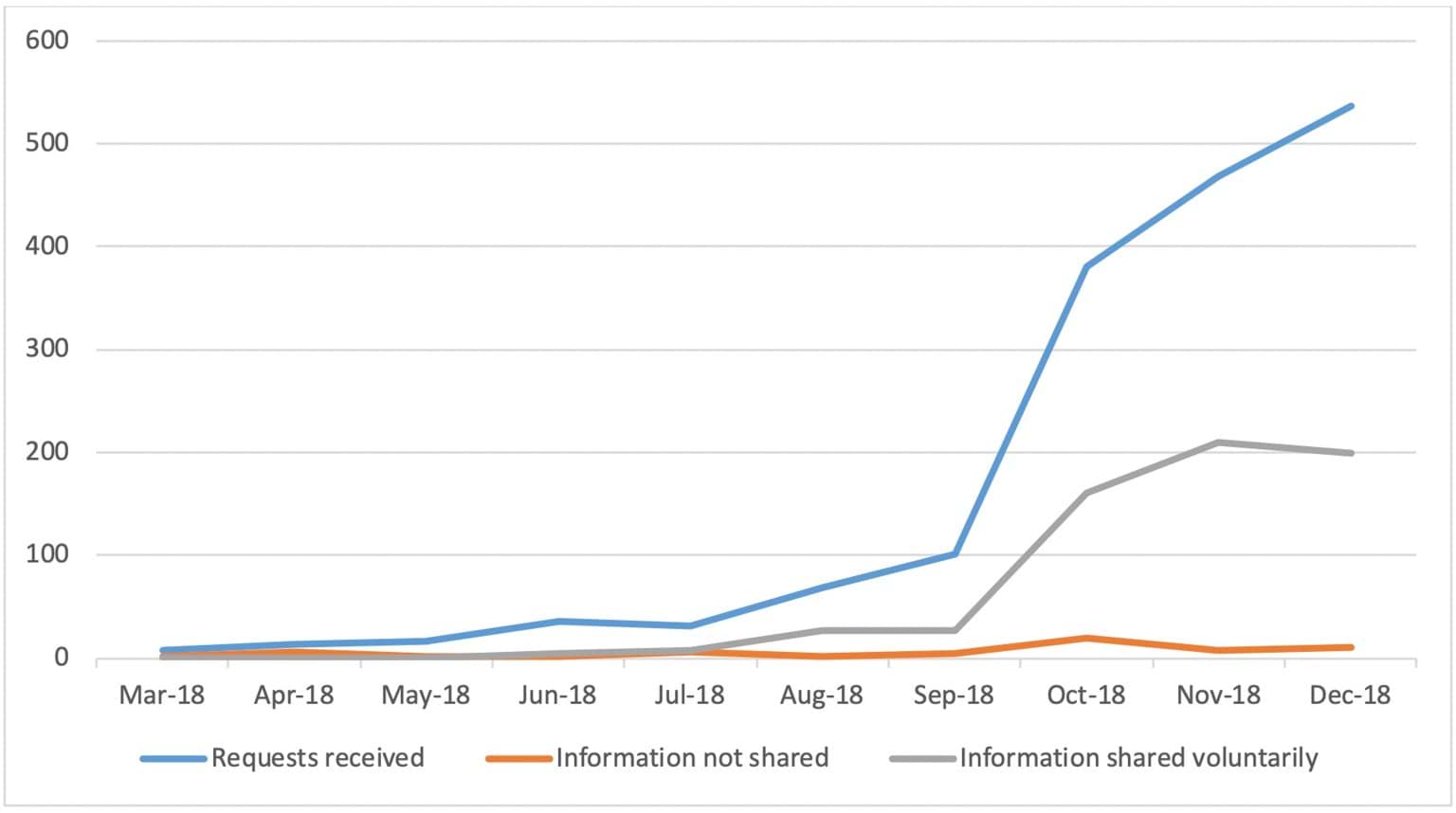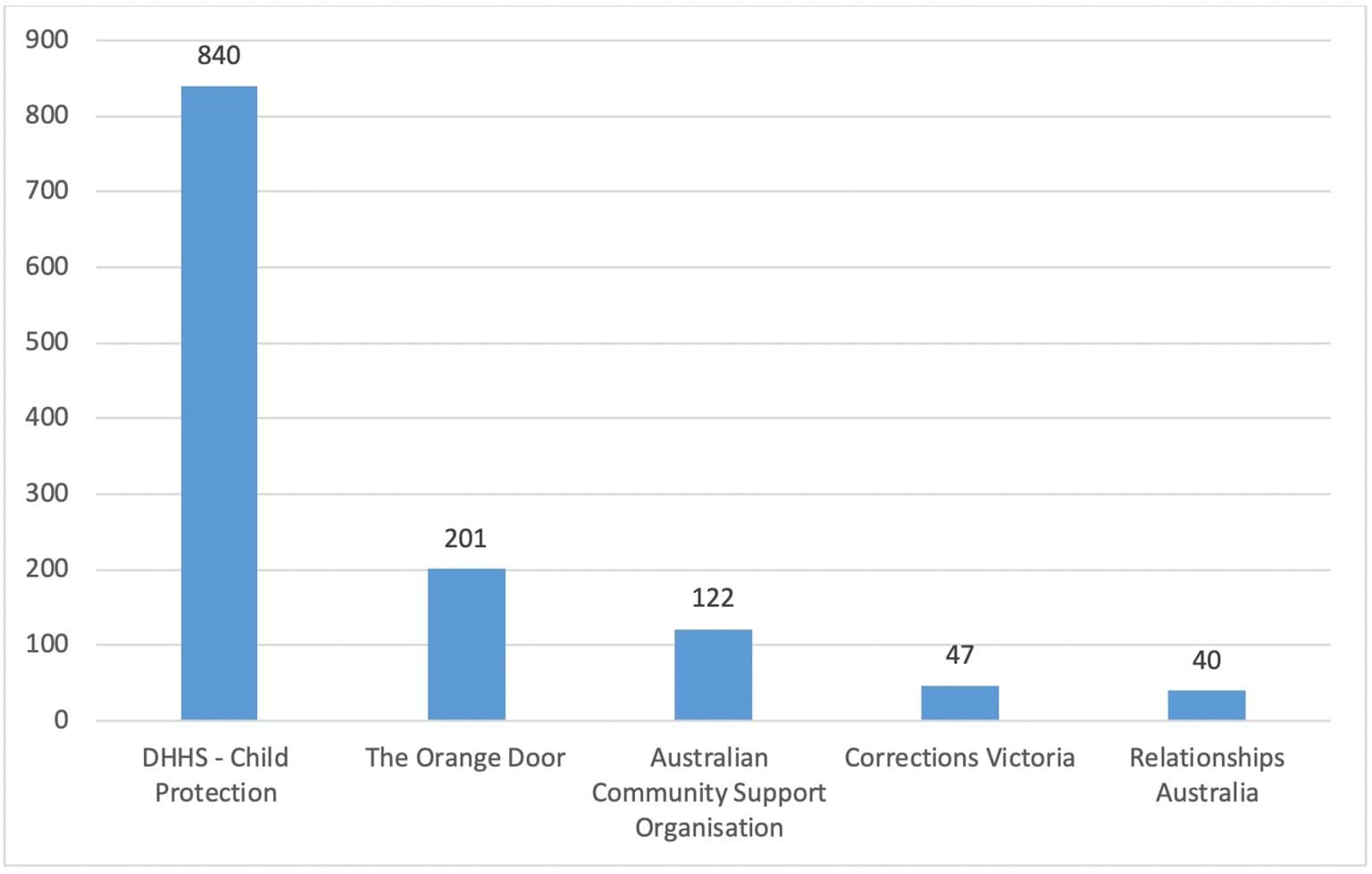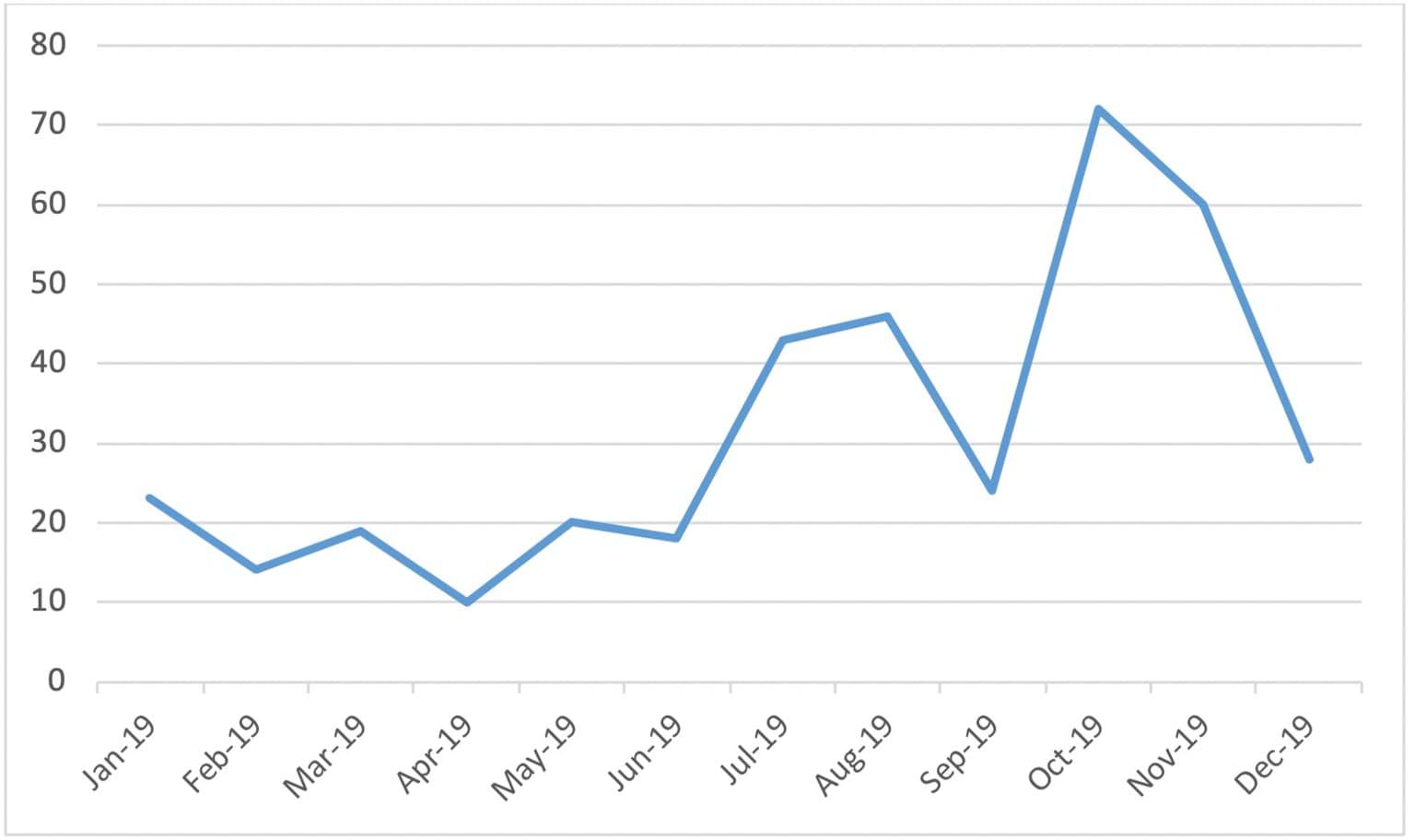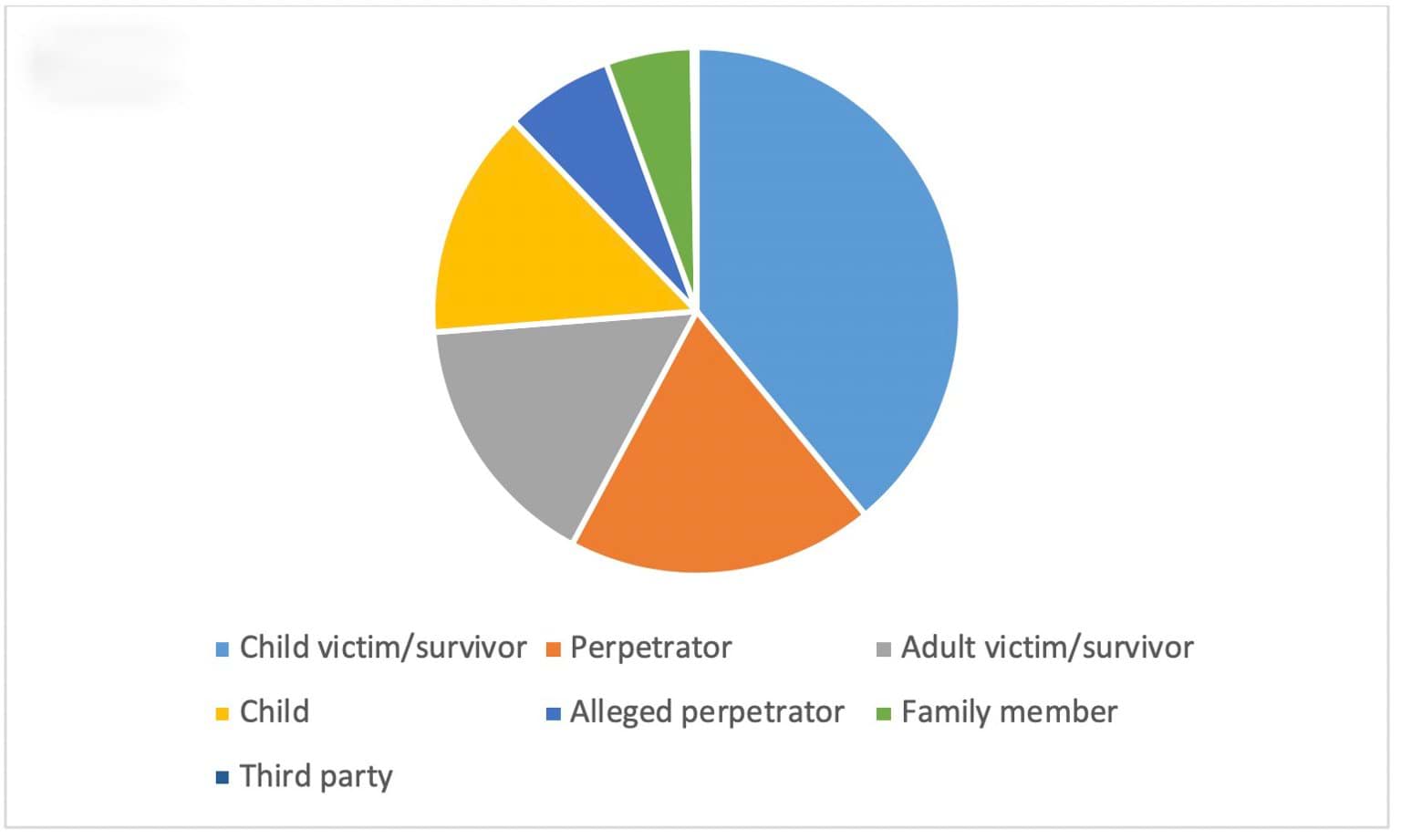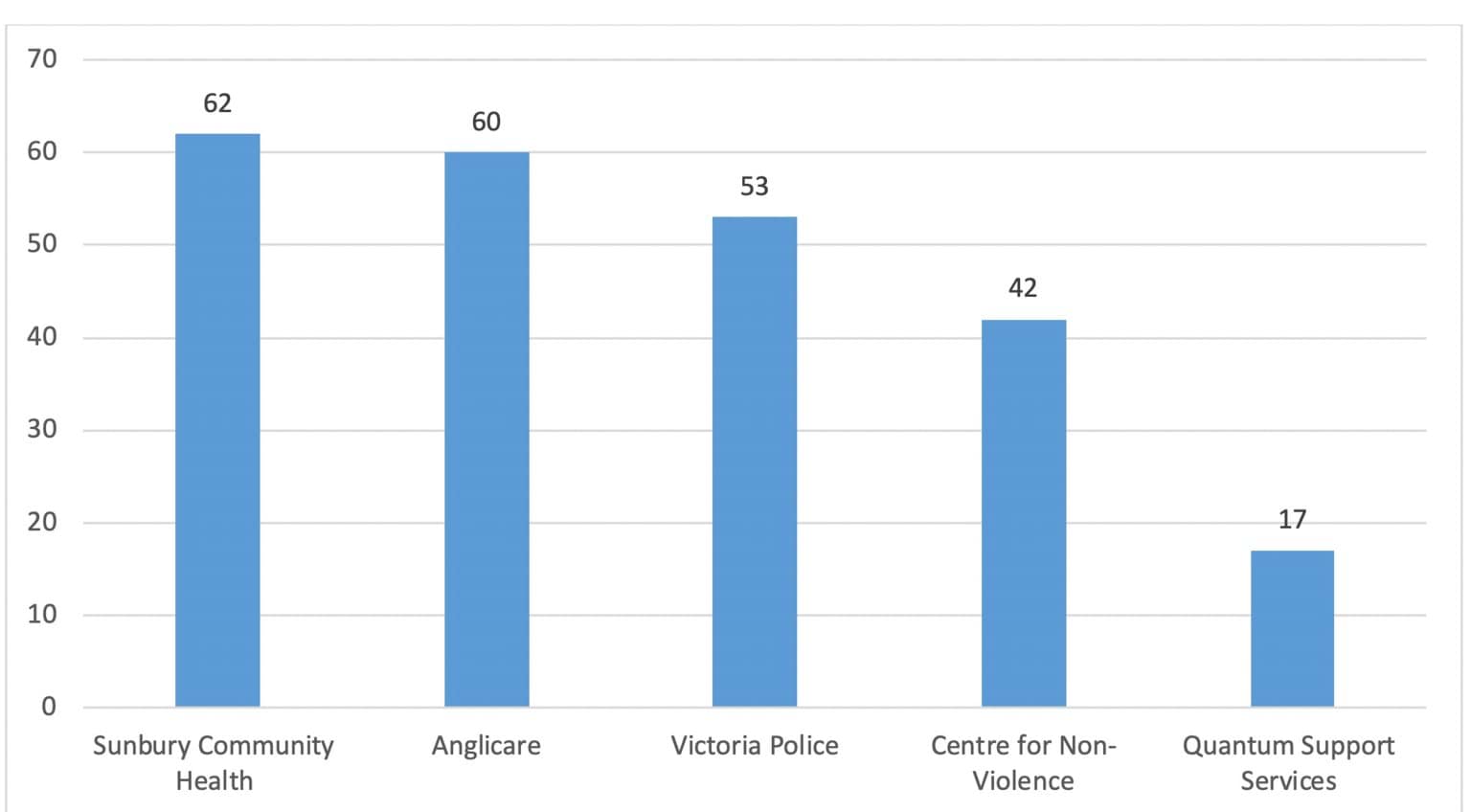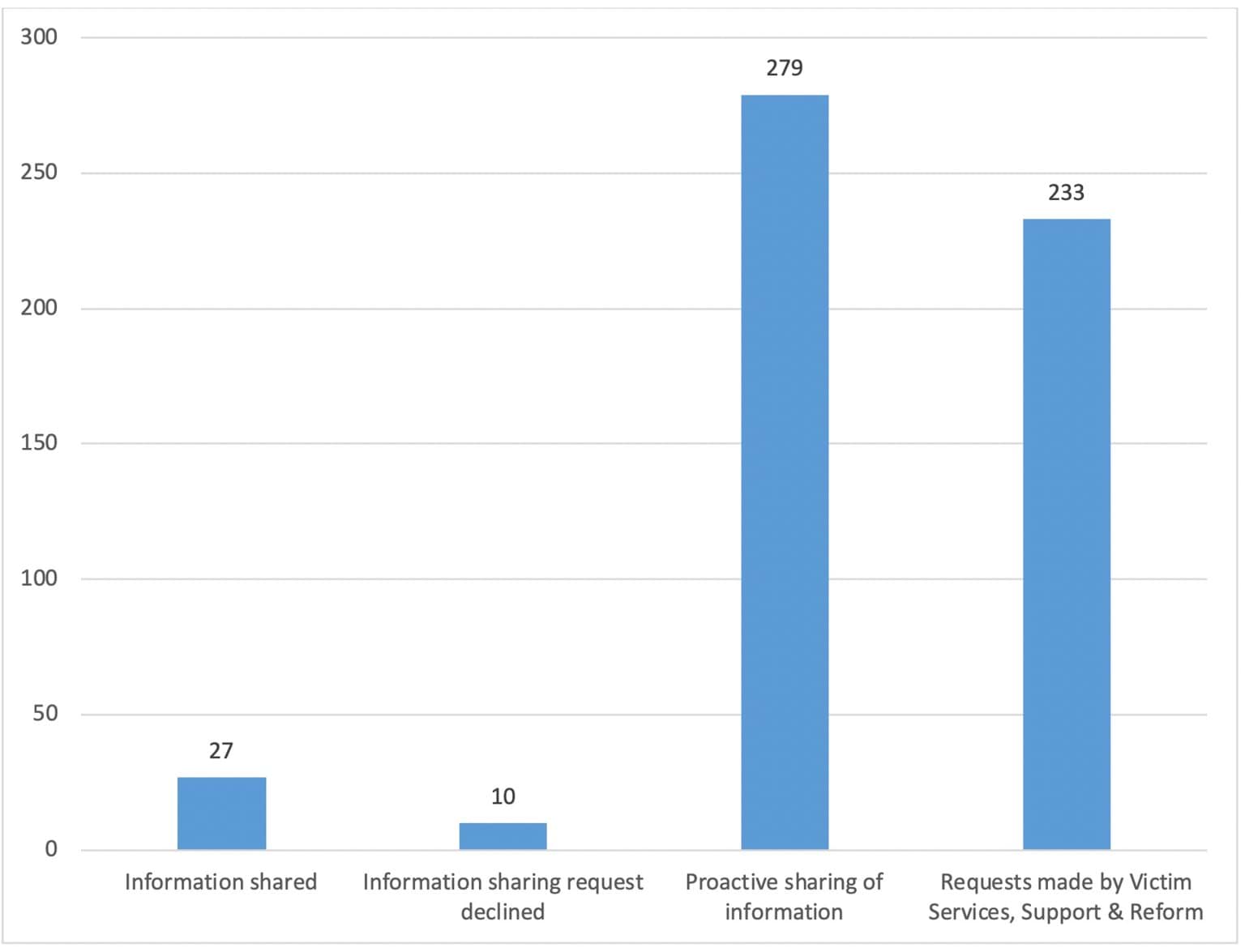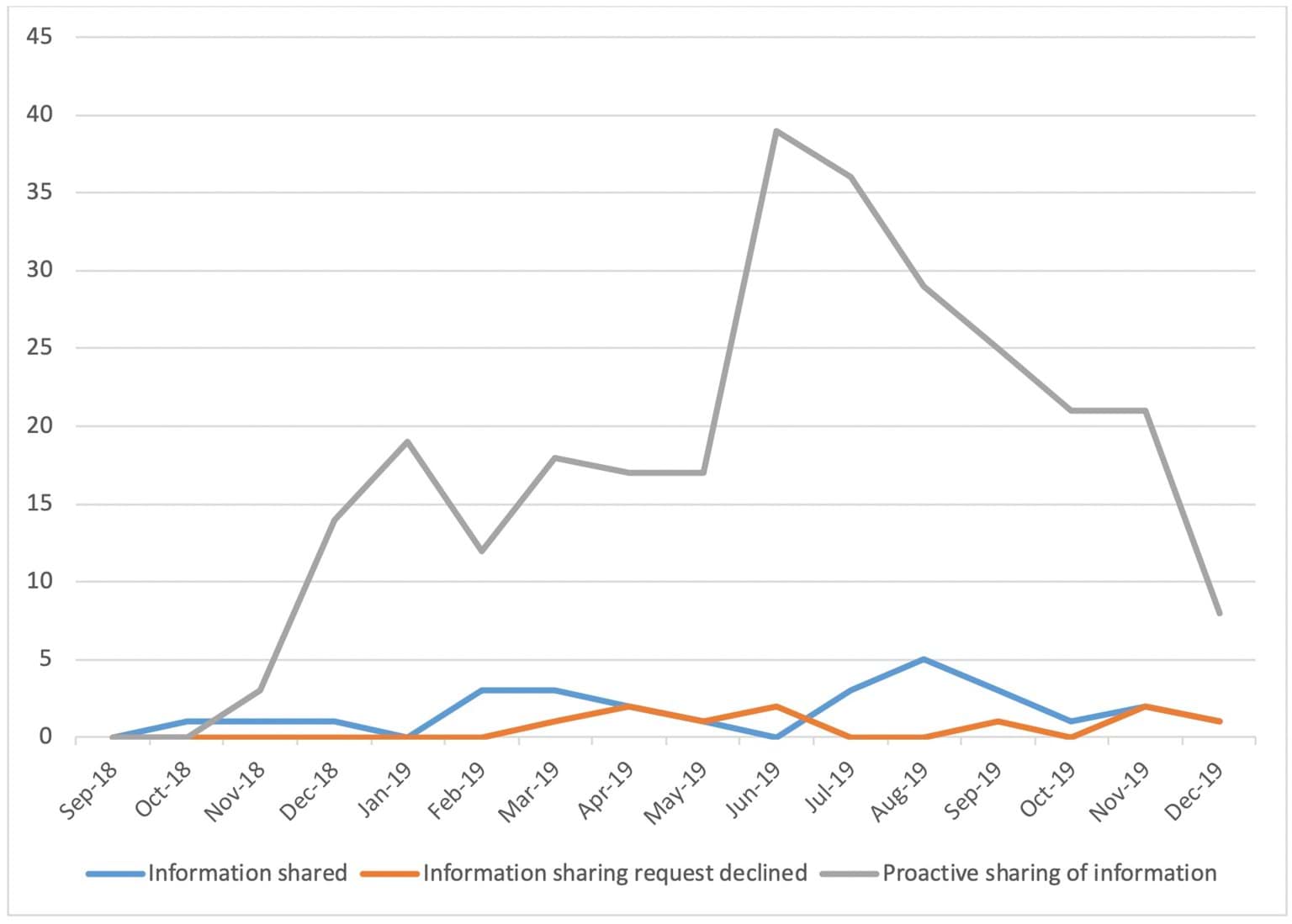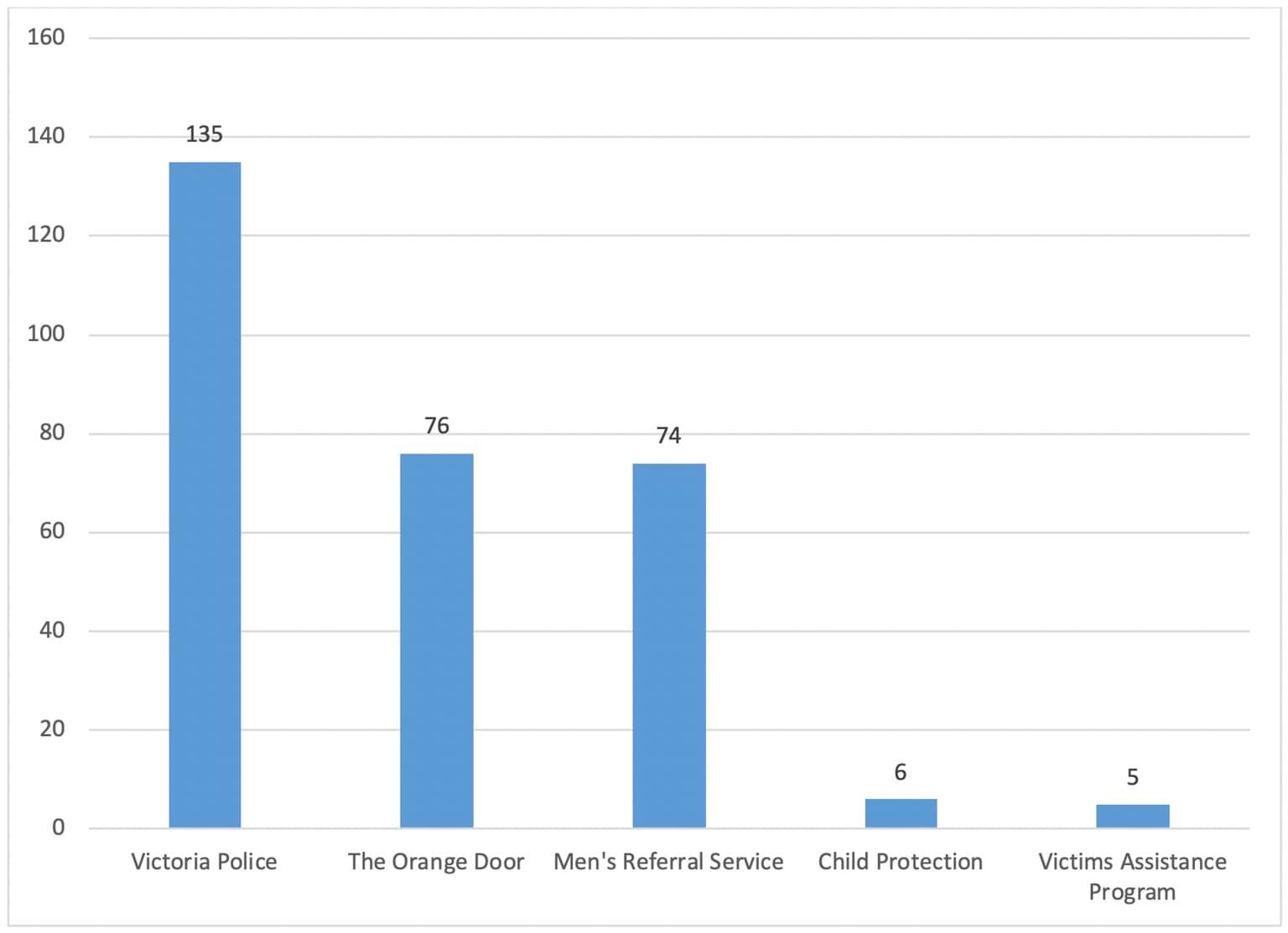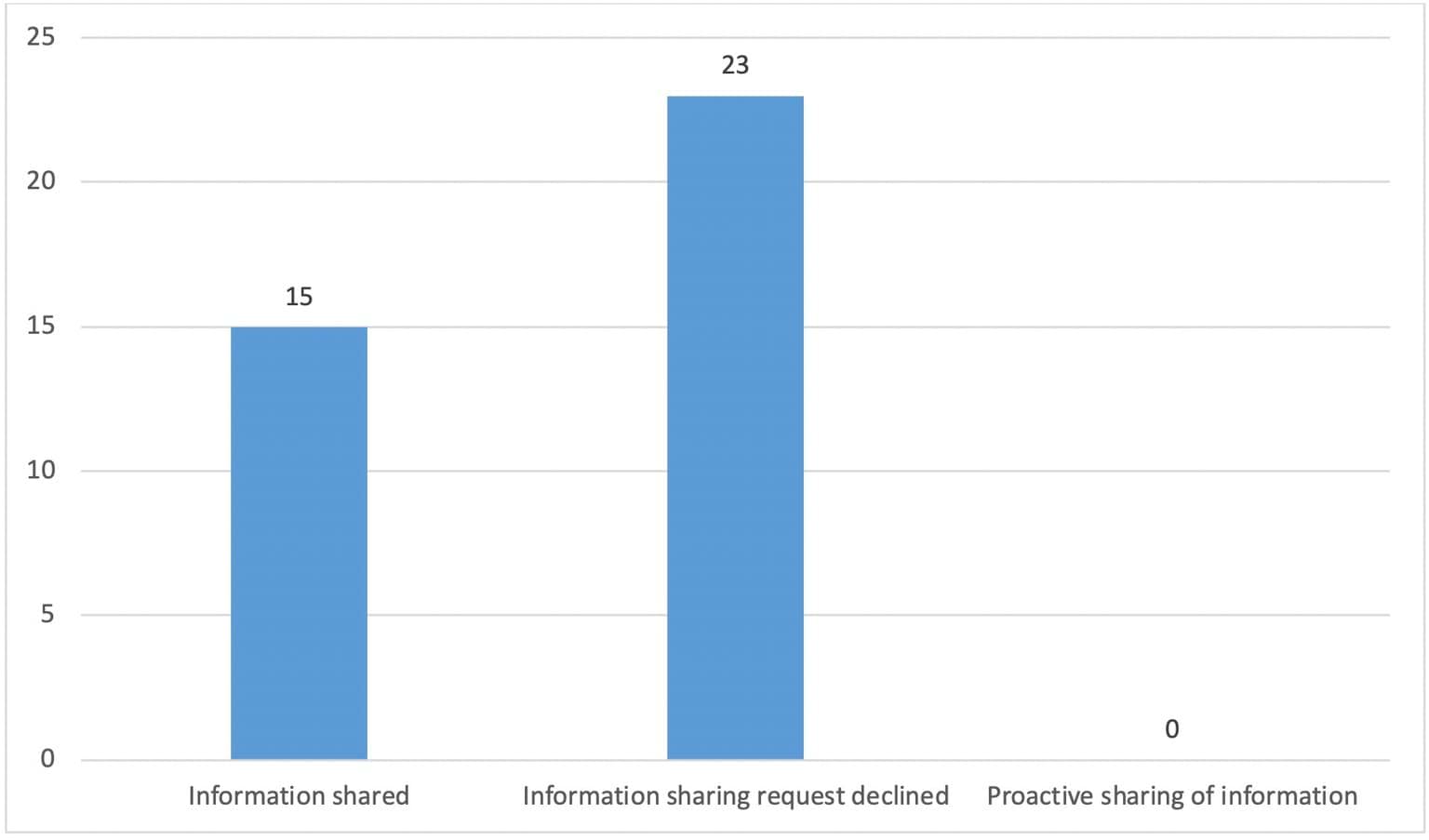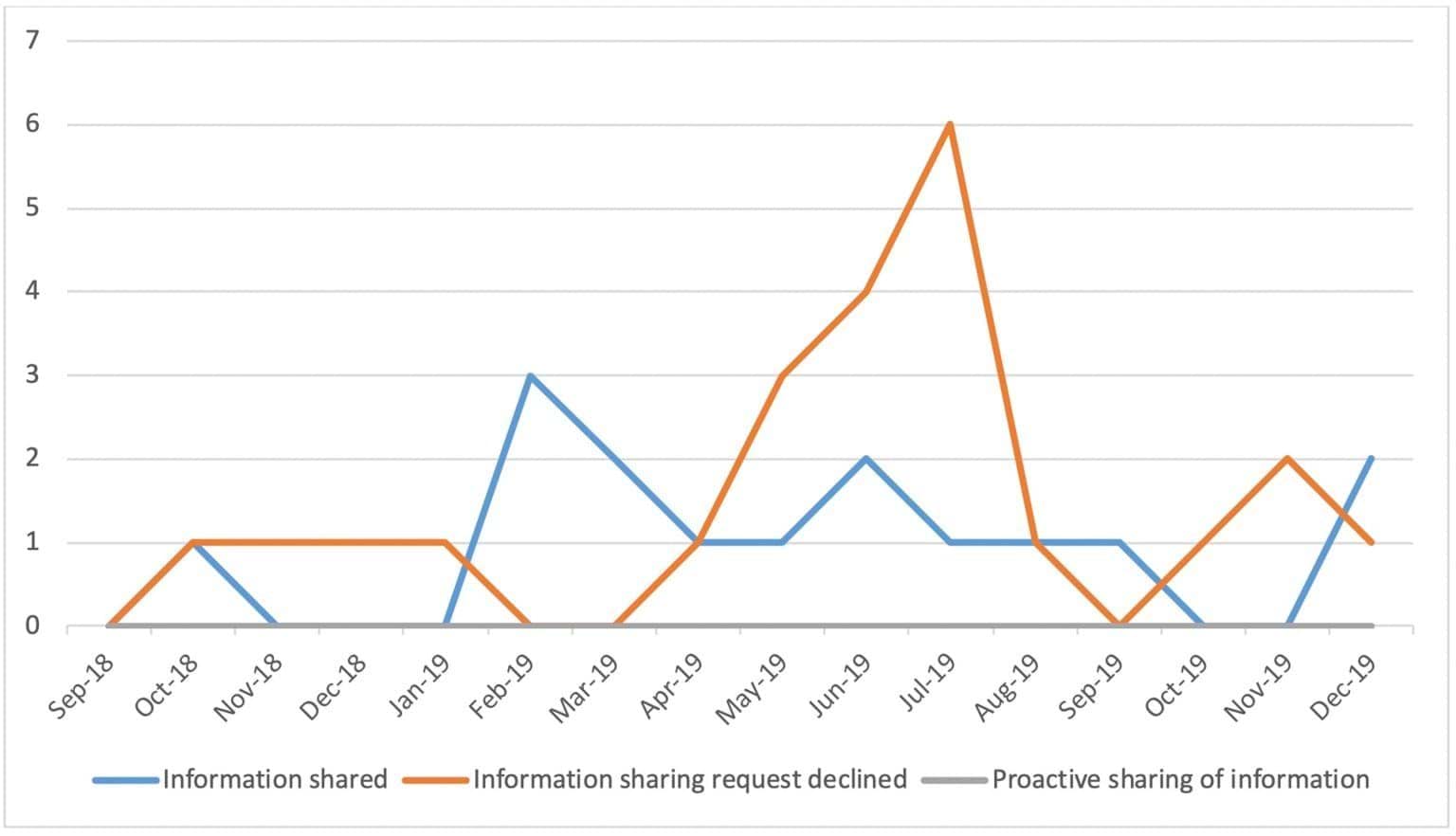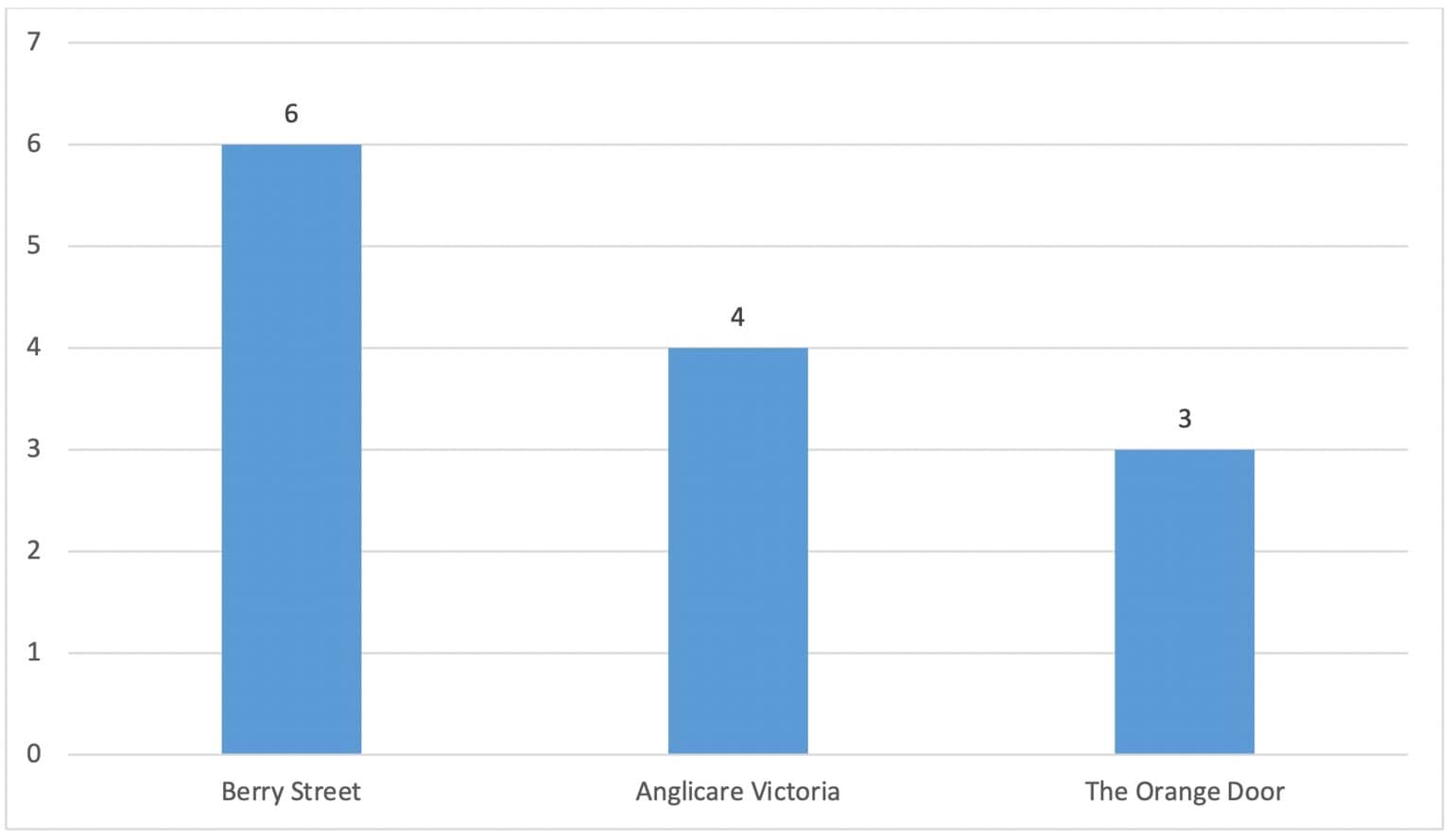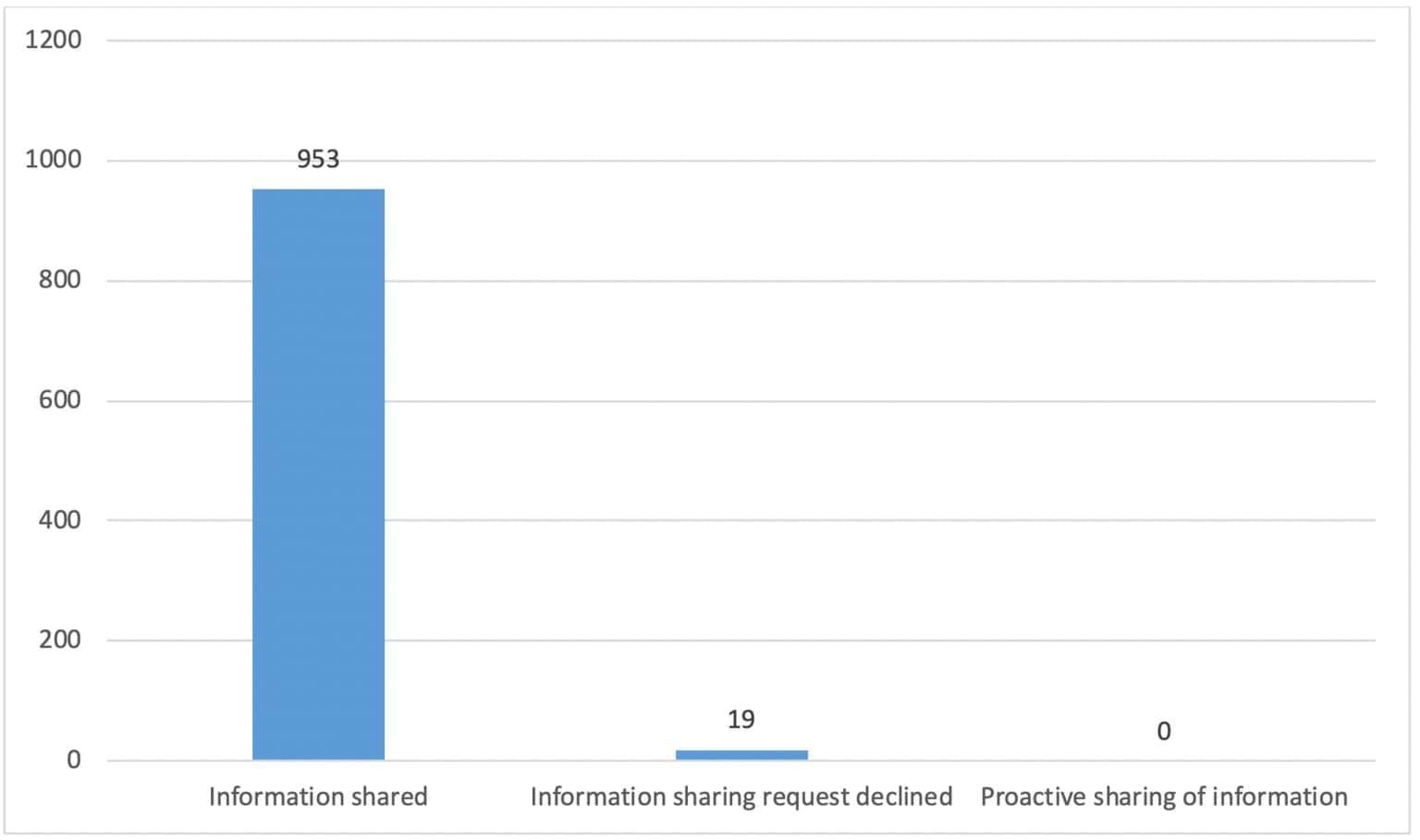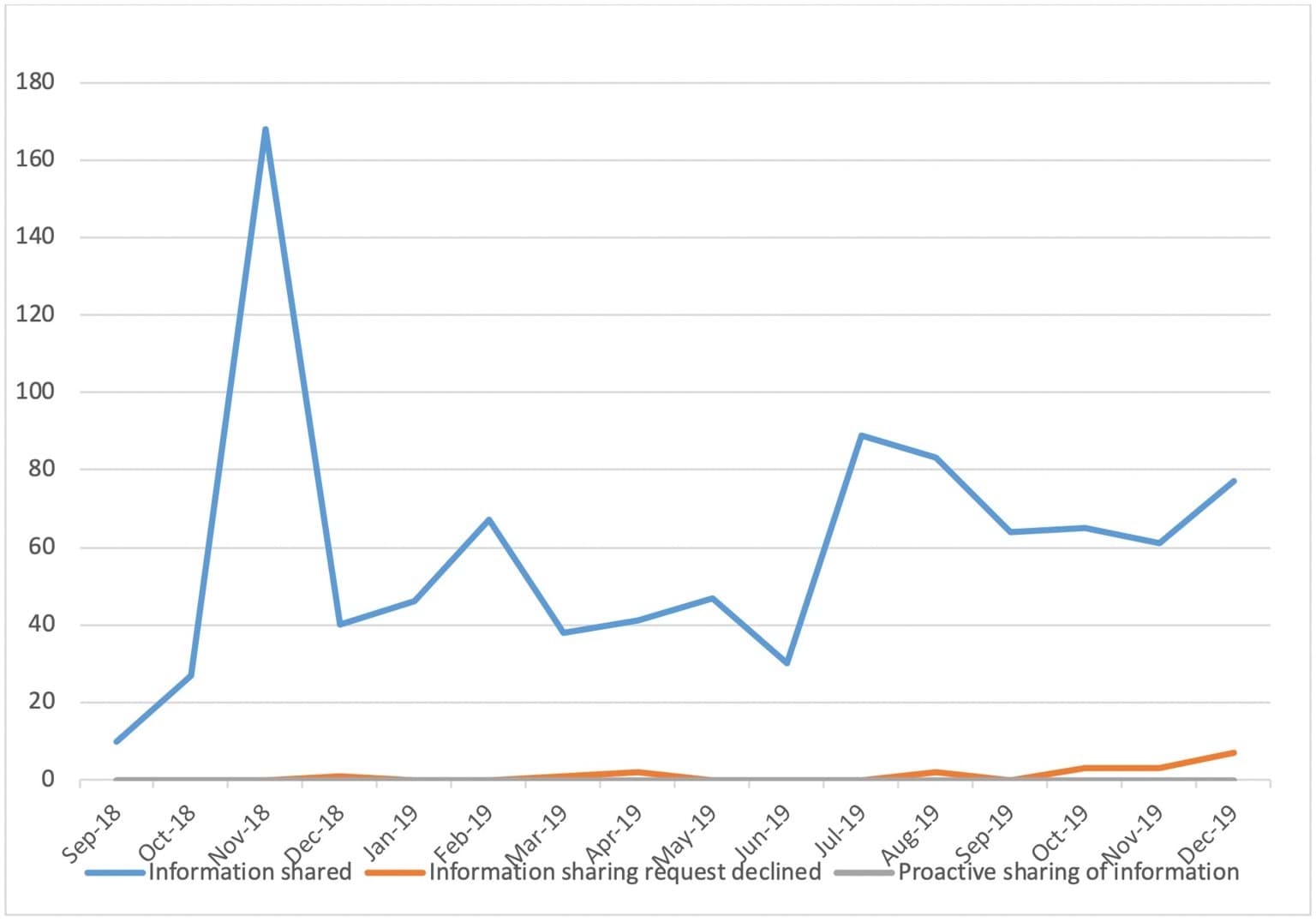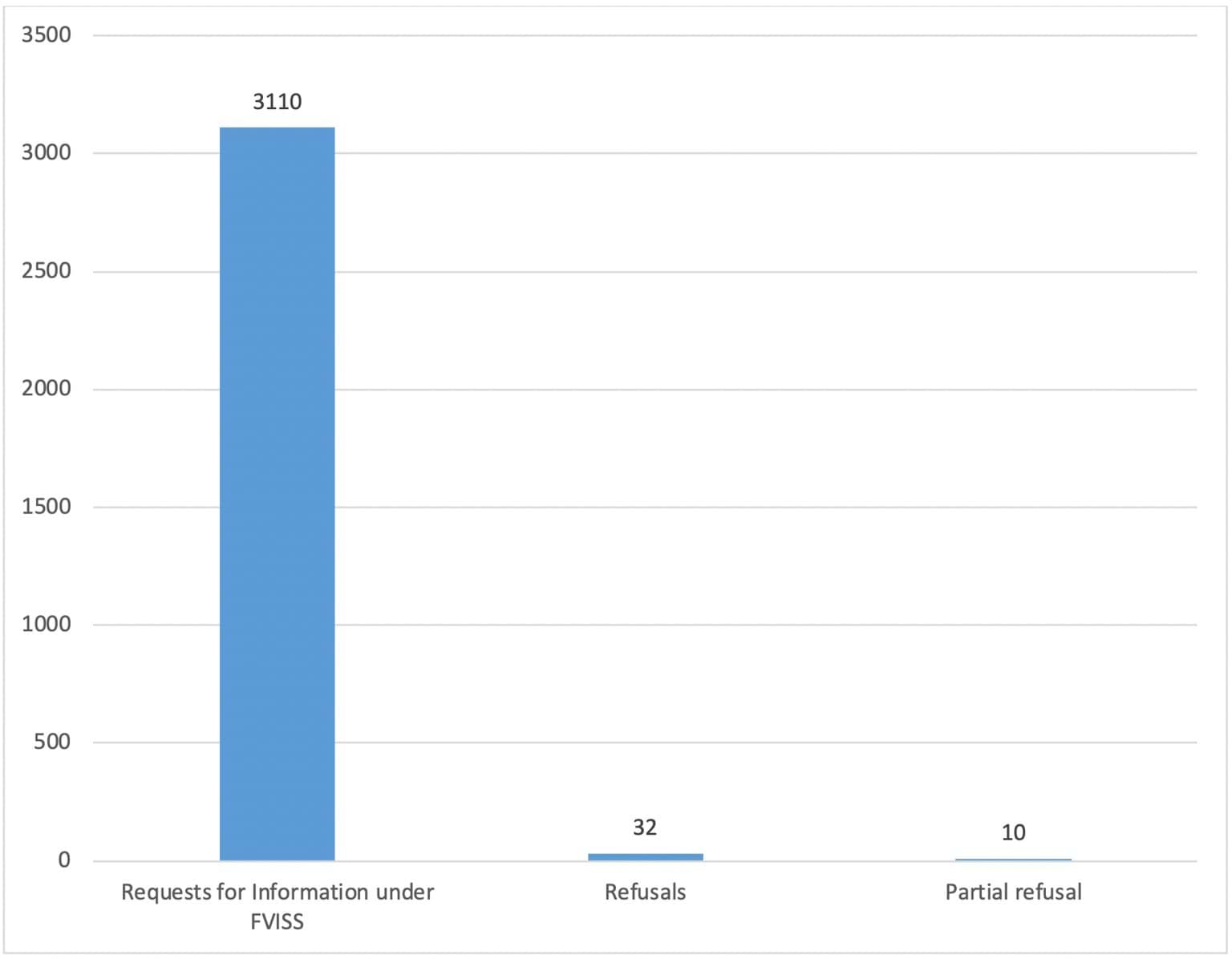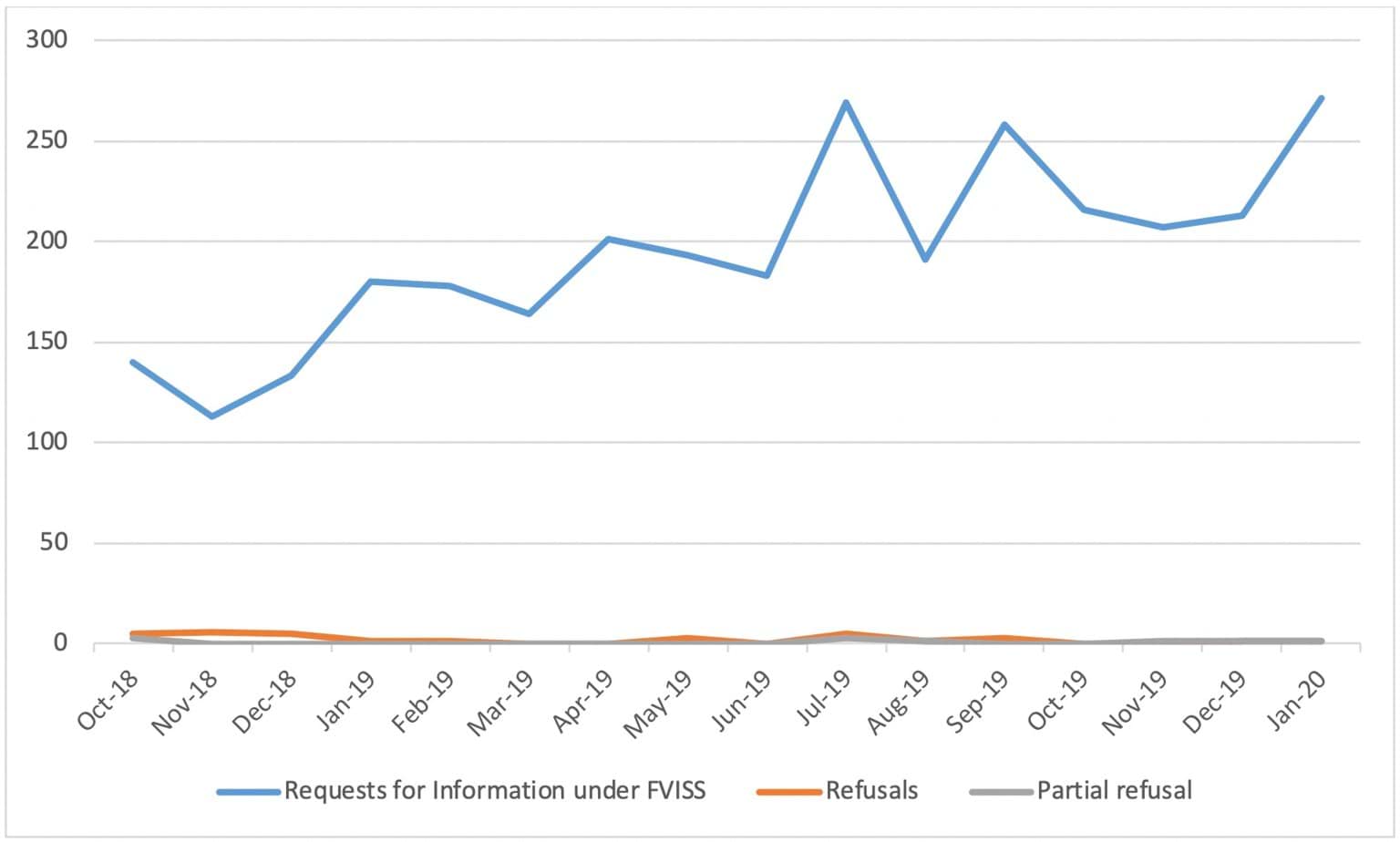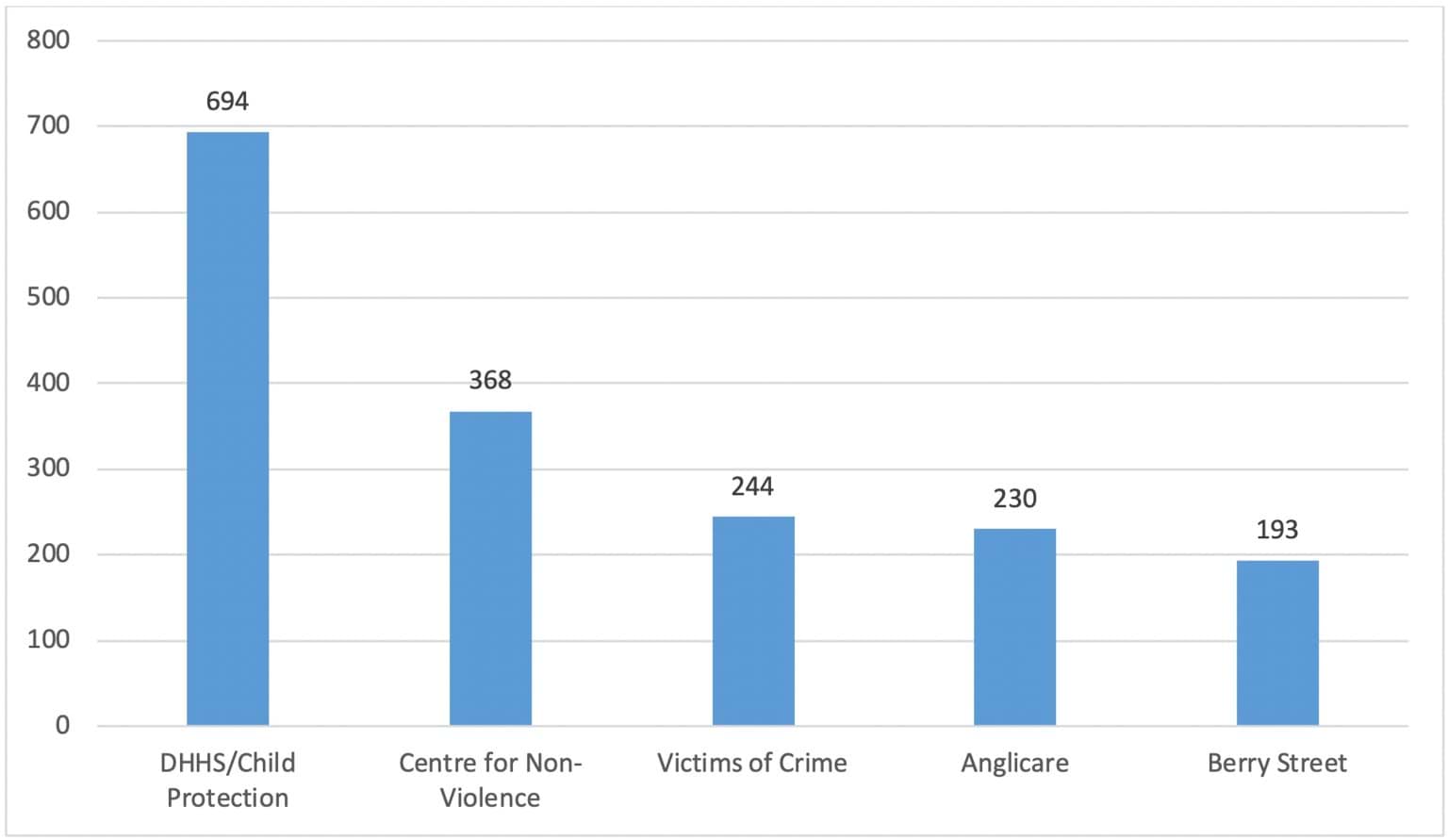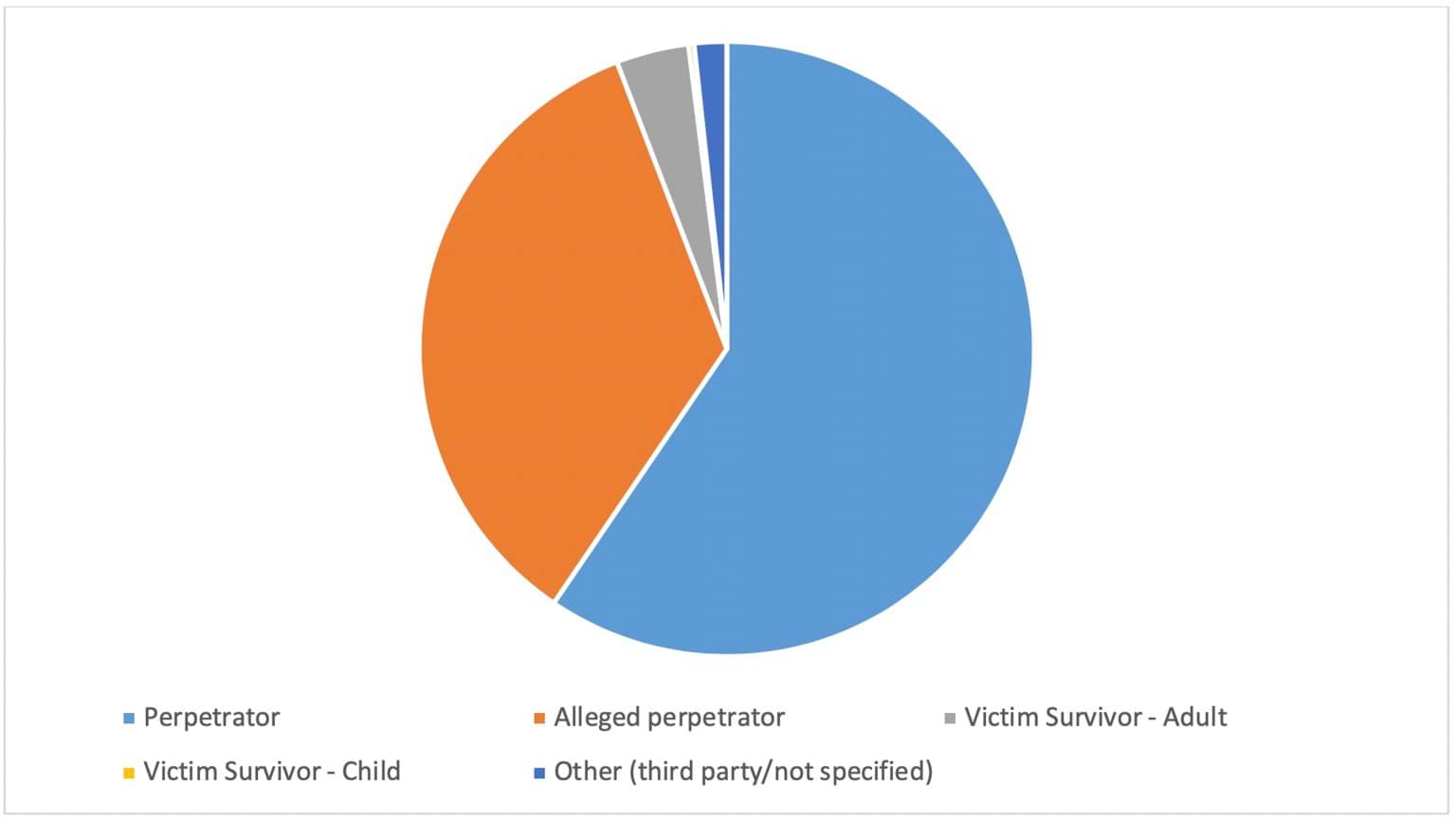Appendix One: List of entities prescribed at each stage of the Scheme
|
FVISS Initial Tranche (26 February 2018) |
FVISS Phase One (September 2018) |
|
Risk Assessment and Management Panels |
Integrated Family Services |
|
Support and Safety Hubs |
Homelessness services* |
|
Community Based Child Protection (Hubs) |
Out of home care* |
|
Specialist Women’s Family Violence Service |
Youth Justice and funded services |
|
Specialist Men’s Family Violence Service |
Child Protection |
|
ChildFIRST |
Maternal and Child Health |
|
Sexual Assault Services |
DHHS Housing* |
|
Victoria Police |
Mental Health* |
|
Magistrates’ Court |
AOD* |
|
Children’s Court |
Youth Parole Board |
|
Victims of Crime Helpline |
Sate Funded Financial Counselling Program |
|
Central Information Point (DHHS employee) |
State Funded Tenancy Assistance Program |
|
Family Violence Counselling |
Justice Health |
|
Corrections Victoria and Correctional Services (including Adult Parole Board) |
Victims Support Agency |
* Partial workforce only (exact roles TBD) (FSV)
Appendix Two: List of documents reviewed
Behavioural Insights Unit (Vic). (2017). Applying behavioural insights: Improving information sharing in the family violence system. Melbourne: Victoria State Government.
Berry Street and Justice Health. Berry Street and Justice Health Case Example. [unpublished].
Cube Group. (2019). Evaluation of the MARAM Reforms – FINAL Interim Phase 1 report: Process evaluation of early implementation, 22 December. [unpublished].
Coroners Court Victoria. (2018). Finding - Inquest into the death of Mettaloka Malinda Halwala, 10 May 2018, Coroner Rosemary Carlin.
Department of Justice and Community Safety. (2019) Family Violence and Child Information Sharing Schemes DJCS: From go live (28 February or 27 September 2018). [unpublished].
Department of Health and Human Services. (2017). Language Services Policy. Victoria: Victoria State Government.
Djirra. (2019). Information Sharing Entities – Victorian Family Violence Sector, Service Providers and Justice Stakeholders: Long form stories of complex issues facing clients of Djirra’s Koori Women’s Place (KWP). [unpublished].
Domestic Violence Resource Centre. (2018). Training Evaluation Report. [unpublished]. (‘DVRCV Training Evaluation Report’)
Family Safety Victoria. 19-20 sector grant project summaries – combined (Domestic Violence Victoria, No To Violence, CASA Forum). [unpublished].
Family Safety Victoria. (2019). CIP Service Verification Report: Information Systems Reform, May 2019. TRIM ID: HHSD/19/205093. [unpublished].
Family Safety Victoria. (2018). Draft communications plan April 2018. [unpublished].
Family Safety Victoria. (2018). Enquiry Line Log. [unpublished].
Family Safety Victoria. Elizabeth Morgan House Aboriginal Women’s Service Project proposal sector support funding - 19-20. [unpublished].
Family Safety Victoria. (2018). Family Violence Information Sharing Guidelines: Guidance for Information Sharing Entities. Victoria: Victoria State Government. (‘Ministerial Guidelines’)
Family Safety Victoria. (2018). Family Violence Information Sharing Training Package. [unpublished].
Family Safety Victoria. (2018). FSV response to Monash Request for Information. [unpublished]
Family Safety Victoria. Implementation support resources register- Updated 8 November 2018. [Unpublished Excel spreadsheet].
Family Safety Victoria. (2018). Interim communications plan February 2018. [unpublished].
Family Safety Victoria. MARAM alignment: Slide pack for discussion. [unpublished PowerPoint presentation].
Family Safety Victoria. (2018). Men’s Behaviour Change Minimum Standards. Victoria: Victoria State Government.
Family Safety Victoria. (2018). Program Logic. [unpublished].
Family Safety Victoria. (2017). Regulatory Impact Statement: Family Violence Protection (information Sharing Regulations 2017 (Final Report). Victoria: Victoria State Government.
Family Safety Victoria. (2018). Summary of the Family Violence Information Sharing Guidelines: Guidance for Information Sharing Entities. Victoria: Victoria State Government.
Family Safety Victoria. (2018). Summary of Pre-Scheme Training numbers. [unpublished].
Family Safety Victoria. WoVG Implementation Plan 121118. [Unpublished Excel spreadsheet].
Family Safety Victoria. WoVG Information Sharing Training Delivery. [Unpublished Excel spreadsheet].
PricewaterhouseCoopers Consulting. (2019). The Orange Door 2018 evaluation. Evaluation Report: Prepared for Family Safety Victoria. [unpublished].
State of Victoria, Australia, Family Safety Victoria. (2019). Regulatory Impact Statement: Family Violence Protection (Information Sharing and Risk Management) Amendment Regulations 2020. Final Report 17 October 2019. [unpublished].
State Government Victoria, Department of Health and Human Services. (2019). End of Project Report: Council to Homeless Persons, 2018-2019. [unpublished].
Victorian Alcohol and Drug Association. (2019). Information Sharing in the AOD Sector, June 2019. [unpublished].
Data on information sharing from key organisations
Corrections Victoria
Corrections Victoria. (2020). FVISS Data Request for Monash. [unpublished Excel spreadsheet].
Department of Health and Human Services
Department of Health and Human Services. (2020) DHHS Information Sharing Unit: Family Violence Information Sharing Scheme 2019. [unpublished].
Magistrates’ Court of Victoria
Magistrates’ Court of Victoria. (2020). Final FVISS Monash Report - February 2018 - January 2020. [unpublished].
Magistrates’ Court of Victoria. (2019). FV Information Sharing: Quarterly Report - October to December 2019. [unpublished].
Magistrates’ Court of Victoria. (December 2019). Family Violence Information Sharing: From Commencement of scheme (as of 31st December) - Dashboard. [unpublished].
Magistrates’ Court of Victoria. (November 2019). Family Violence Information Sharing: Reporting November 2019 - Dashboard. [unpublished].
Magistrates’ Court of Victoria. (October 2019). Family Violence Information Sharing: Reporting October 2019 - Dashboard. [unpublished].
Magistrates’ Court of Victoria. (September 2019). Family Violence Information Sharing: Reporting September 2019 - Dashboard. [unpublished].
Magistrates’ Court of Victoria. (2019). FV Information Sharing: Monthly Report - August 2019. [unpublished].
Magistrates’ Court of Victoria. (2019). FV Information Sharing: Monthly Report - July 2019. [unpublished].
Magistrates’ Court of Victoria. (2019). FV Information Sharing: Monthly Report - June 2019. [unpublished].
Magistrates’ Court of Victoria. (2019). FV Information Sharing: Monthly Report - May 2019. [unpublished].
Magistrates’ Court of Victoria. (2019). FV Information Sharing: Monthly Report - April 2019. [unpublished].
Magistrates’ Court of Victoria. (2019). FV Information Sharing: Monthly Report - March 2019. [unpublished].
Magistrates’ Court of Victoria. (2019). FV Information Sharing: Monthly Report - February 2019. [unpublished].
Magistrates’ Court of Victoria. (2019). FV Information Sharing: Monthly Report - January 2019. [unpublished].
Magistrates’ Court of Victoria. (2018). FV Information Sharing: Monthly Report - December 2018. [unpublished].
Magistrates’ Court of Victoria. (2018). FV Information Sharing: Monthly Report - November 2018. [unpublished].
Magistrates’ Court of Victoria. (2018). FV Information Sharing: Monthly Report - October 2018. [unpublished].
Magistrates’ Court of Victoria. (2018). FV Information Sharing: Monthly Report - September 2018. [unpublished].
Magistrates’ Court of Victoria. (2018). FV Information Sharing: Monthly Report - August 2018. [unpublished].
Magistrates’ Court of Victoria. (2018). FV Information Sharing: Monthly Report - July 2018. [unpublished].
Magistrates’ Court of Victoria. (2018). FV Information Sharing: Monthly Report - June 2018. [unpublished].
Magistrates’ Court of Victoria. (2018). FV Information Sharing: Magistrate’ Court and Children’s Court - Report for March/April/May 2018. [unpublished].
Victoria Police
Victoria Police. (2020). FVISS Data Oct 18 - Family Violence Information Sharing Scheme (FVISS) Data: Victoria Police - Inter-agency Information Sharing Service [October 2018 - January 2020, unpublished Excel spreadsheet].
Documents from FSV collated as ‘FSV Progress Report on Implementation June 2019’
Family Safety Victoria. ATT 1 Training Needs Analysis: WoVG Information Sharing Training Delivery. [Unpublished Excel spreadsheet].
Family Safety Victoria. ATT 2 ISTA training schedule: Information Sharing Training Approach (ISTA) Sessions October – December 2018. [Unpublished Word document].
Family Safety Victoria. ATT 3 Info Sharing Training_Attendance-Register face to face training on FVISS and CISS October to December 2018. [Unpublished Excel spreadsheet].
Family Safety Victoria. ATT 4 Email communications tracker FVISS and MARAM July 2018 - April 2019. [Unpublished Excel spreadsheet].
Family Safety Victoria. ATT 5 Training-Evaluation-Data ISTA training October-December 2018. [Unpublished Excel spreadsheet].
State Government Victoria. (2019) Information Sharing and Introduction to MARAM Training: Evaluation Report – March 2019 (ATT 6 DET Information Sharing Training Evaluation Report). [unpublished].
Family Safety Victoria. ATT 7 Sector Grant Recipients contact list 2018-19. [Unpublished Excel spreadsheet].
Family Safety Victoria. ATT 8 Sector grant workplans 2018-2019. [Unpublished Excel spreadsheet].
Family Safety Victoria. ATT 9 NTV March_ISE Survey Results. [Unpublished].
Family Safety Victoria. (2019) ATT 10 Sector Capacity Building Working Group: Key Challenges, 30 April 2019. [Unpublished].
Family Safety Victoria. ATT 11 Sector Capacity Building Aboriginal Working Group: Key Challenges, 5 March 2019. [Unpublished].
Family Safety Victoria. Multi-Agency Risk Assessment and Management and Information Sharing (MARAMIS) Project Plan (ATT 12 Project Plan Risk Management and Information Sharing team September 2018 to June 2020. [Unpublished].
Family Safety Victoria. ATT 13 Project Status Report to Interdepartmental Committee for Family Violence Reform March 2019 - Project: Multi-Agency Risk Assessment and Management and Information Sharing (MARAMIS). [Unpublished].
ATT 14 FSV Implementation Plan- Updated March 2019: MARAMIS Engagement and Communications Schedule. [Unpublished Excel spreadsheet].
Family Safety Victoria. ATT 15 Implementation Resource Register (updated 16 May). [Unpublished].
Family Safety Victoria. (2019). Family Safety Victoria Updated Progress Report: FVISS, June 2019. [Unpublished].
Documents from FSV collated as ‘FSV Progress Report on interim report Dec 2019_Final’
Family Safety Victoria. Attachment 1 Online Module-2-evaluation-survey-all-responses-30 Oct 2019. [Unpublished].
State Government Victoria, Department of Health and Human Services. Attachment 2 DHHS Information Sharing Scheme training numbers and locations. [Unpublished].
Family Safety Victoria. Attachment 3 Training evaluation data DHHS one day info sharing training sessions. [Unpublished].
Family Safety Victoria. Attachment 4 Session Overview for collaborative practice MARAM training. [Unpublished].
Family Safety Victoria. Attachment 5 Project Status Report September MARAMIS. [Unpublished].
Family Safety Victoria. (2019) Information Sharing and MARAM: Implementation Resources Register, October 2019 (Attachment 6 - Implementation Resource Register). [Unpublished].
Family Safety Victoria. Attachment 7 - Email communications tracker October 2019: Email communication – From June 2018. [Unpublished Excel spreadsheet].
Family Safety Victoria. Attachment 8 - Info sharing resources webpage - September data. [Unpublished].
Family Safety Victoria. Attachment 9 - Vic gov downloads- breakdown- September data. [Unpublished].
Family Safety Victoria. (2019). Enquiry Line data: November 2018 – October 2019 (Attachment 10 - Enquiry-line-data October 2019). [Unpublished].
Family Safety Victoria. Attachment 11 - FVIS - Email Enquiries Spreadsheet – 2019. [Unpublished Excel spreadsheet].
Family Safety Victoria. (2019). Family Safety Victoria Updated Progress Report: FVISS, December 2019. [Unpublished].
Appendix Three: List of relevant Australian and international information sharing schemes/legislation and evaluations
A summary of existing legislation governing information sharing in the context of family violence was identified by the RCFV in 2016 (see Table 7.4, State of Victoria 2016a: 183-184). As this is a rapidly evolving area, this Appendix replicates the RCFV’s table (see grey-shaded boxes), adding additional legislation that has been introduced since 2016, implements child information sharing schemes similar to the FVISS, or has been identified in other literature (e.g. see table summarising legislation in the DFV bench book, itself adapted from Taylor et al. 2015, p. 15), along with identification of additional relevant evaluations of existing schemes in Australian and relevant international jurisdictions. For a more comprehensive overview of the contexts in which the following Australian state and territory provisions operate (see Glanfield 2016).
|
Australia |
|||
|
Jurisdiction |
Legislation |
Description |
Evaluation (2012 – 2018) |
|
Australian Capital Territory |
s18, Domestic Violence Agencies Act 1986 |
This section provides for a police officer or a staff member of the Australian Federal Police to disclose information to an approved crisis support organisation for the purpose of rendering assistance to victim/survivors of family violence or their children. |
No specific evaluation identified, although the 2016 Glanfield Inquiry noted that: ‘The Inquiry is of the impression that this provision is underutilised as no non-government organisation has been approved since the DVCS in 1992 and instead section 136, discussed below, is relied upon’ (Glanfield 2016, p. 81). |
|
s136, Crimes (Sentencing Act) 2005 |
This section applies to any information in relation to an offence (including an alleged offence) in a record of a criminal justice entity (including specific agencies and prescribed crisis support services), including information about a person charged with the offence; and a victim/survivor of the offence; and a person convicted or found guilty of the offence. The criminal justice entity may give the information to another criminal justice entity for the purposes of the other entity. According to the Glanfield Inquiry, ‘This is the basis upon which the FVIP members share information' (Glanfield 2016). |
No specific evaluation identified |
|
|
Divisions 25.3.2 and 25.3.3, Children and Young People Act 2008 |
As a result of three ACT inquiries relating to family violence, these divisions were introduced in 2016 by the Reportable Conduct and Information Sharing Legislation Amendment Bill 2016. These divisions enable prescribed entities to share safety and wellbeing information and reportable conduct information relating to children, including about a child’s family members, relevant to the health, safety or wellbeing of the child or young person. The ACT Government has also indicated further legislation specifically for family violence may be considered after further consultation (ACT Government 2016, p. 9) |
No specific evaluation identified |
|
|
New South Wales |
Part 13A, Crimes (Domestic and Personal Violence) Act 2007 |
This part establishes an information-sharing regime for family violence. It specifically overrides NSW information privacy legislation by authorising the disclosure of personal information and health information relating to both victim/survivors and perpetrators of family violence. Because the information-sharing regime integrates with the NSW Safer Pathway reforms, information can be shared with a central referral point (to electronically manage and monitor family violence referrals) and a statewide network of local coordination points (non-government family violence services). Most information sharing requires the consent of the victim/survivor but not the consent of the perpetrator or alleged perpetrator. In situations of serious threat, the consent of the victim/survivor can be overridden. The legislation also expressly prevents perpetrators from gaining access to information collected about them under the regime. |
In 2017, BOCSAR evaluated the NSW’s Safer Pathway program’s effectiveness, however information sharing was not evaluated specifically, and was identified as an area for future research (Trimboli 2017, pp. 2, 16). A second evaluation of longer-term outcomes is currently underway (see Coote & Clift 2017). |
|
Chapter 16A, Children and Young Persons (Care and Protection) Act 1998 |
This chapter establishes an information sharing regime to facilitate the provision of services to children and young persons by agencies that have responsibilities relating to their safety, welfare or wellbeing. The chapter authorises those agencies to share information and requires them to take reasonable steps to coordinate their services. The regime applies to certain prescribed bodies and provides protection from civil or criminal liability for persons, acting in good faith, who provide information in accordance with the legislation. Other laws prohibiting or restricting the disclosure of information are expressly overridden so as not to operate to prevent information sharing under the regime. |
Evaluated by Cassells et al. (2014) and Keeley et al. (2015). Cassells et al. (2014, p. 83) concluded: ‘Information sharing between agencies has improved across the board.’ Keeley et al. concluded: ‘the existence of specific legislative authority for sharing information in certain circumstances such as Chapter 16A of the Children and Young Persons (Care and Protection Act) 1988 (NSW) … has clearly been helpful in the ongoing development of a culture of appropriate information sharing in New South Wales.’ (Keeley et al. 2015, p. 88). |
|
|
Tasmania |
s37, Family Violence Act 2004 |
This section provides that ‘a personal information custodian, within the meaning of the Personal Information Protection Act 2004, acting in good faith, does not commit a breach of that Act by reason only of collecting, using, disclosing or otherwise dealing with personal information for the purpose of furthering the objects of this Act’. The effect of this provision is to override Tasmania’s information privacy legislation where information is shared, in good faith, to further the ‘safety, psychological wellbeing and interests of people affected by family violence’. |
In 2014, Tasmania’s Safe at Home project was reviewed by the Tasmanian Government. Section 37 was briefly noted to be a key enabler of information sharing (Department of Justice (Tas) 2015, p. 56), The provision otherwise does not appear to have been evaluated in depth recently. |
|
ss14 and 53B, Children, Young Persons and Their Families Act 1997 |
These provisions enable the sharing of information relating to children between entities, including where there are concerns about being affected by family violence. |
As above. |
|
|
Western Australia |
s70A, Restraining Orders Act 1997 and r 15 Restraining Orders Regulations 1997 |
This section provides for the exchange of ‘prescribed information’ between a limited number of ‘interested parties’ (government organisations). … An interested party may provide to another interested party prescribed information if the parties agree that the provision of such information is necessary to ensure the safety of a person protected by a violence restraining order or the wellbeing of a child affected by such an order. The information must be provided in confidence, and there are protections from exposure to civil or criminal liability, or professional standards if information is shared in accordance with the section. |
No specific evaluation identified. |
|
Memorandum of Understanding (Government of Western Australia) |
Also see the Government of Western Australia’s (2011) Memorandum of Understanding which outlines the commitments of signatory agencies until 2022, including the interaction of a number of legislative provisions for sharing information (see section 8.3). |
||
|
s28B of the Children and Community Services Act 2004 |
Section 28B of the Children and Community Services Act 2004 was updated in 2015 to allow non-government organisations to share information, including relating to the safety of a person subjected or exposed to family violence. |
The Children and Community Services Act 2004 was reviewed in 2012 by the WA Parliament, which found that: ‘the information sharing provisions are generally operating effectively to support the objects of the Act. However, as referred to in several submissions, there is a need to strengthen information sharing particularly between government and non-government agencies’ (Parliament of Western Australia 2012, p. 10), and recommended ‘sections 34 and 24A should expressly enable the sharing of information relevant to the provision of services to persons experiencing family and domestic violence’ (Parliament of Western Australia 2012, p. 2). It also appears to have been internally reviewed in 2015: ‘In 2015, the Department [for Child Protection and family Support] internally reviewed its family and domestic violence practice and casework practice guidance … The majority of the Family and Domestic Violence review’s findings were implemented through changes to the Department’s policy and case practice guidance. However, a small number of findings related to the adequacy of the Act for supporting the safety of child and adult victim’ (Department for Child Protection and Family Support (DCPFS) (WA) 2016, p. 23). Recent Family Law Council reports also recommend increased family violence information sharing (Department of Communities (WA) 2017, p. 63). |
|
|
South Australia |
N/A |
South Australia does not have information privacy legislation equivalent to the Privacy and Data Protection Act or the Health Records Act. Instead, the South Australian Cabinet has issued an administrative instruction, requiring government agencies and contracted service providers to comply with a set of Information Privacy Principles.219 Consistent with the administrative instruction, the South Australian Ombudsman has issued the Information Sharing Guidelines for Promoting Safety and Wellbeing, which ‘provide [for] a consistent statewide approach to appropriate information sharing practice wherever there are threats to safety and wellbeing’ |
Discussion papers of the South Australian Ombudsman’s Information Sharing Guidelines were released in 2013 (Ombudsman SA) and 2016 (Government of South Australia). |
|
Victoria |
Part 5A, Family Violence Protection Act 2008 |
Similar to NSW family violence and child safety information sharing regimes, this part sets ups an information sharing regime that enables prescribed entities (including government agencies and support services) to share information voluntarily and when requested with other prescribed entities for risk assessment and protection purposes. The information can be about victim/survivors, perpetrators or third parties. Consent is required from the victim/survivor and third parties, unless the victim/survivor is a child. Consent is not required from the perpetrator. Information sharing and risk assessment entities are prescribed as staff from certain agencies and organisations. The legislation includes a defence for disclosing information in good faith. |
Currently being evaluated by the Monash Gender and Family Violence Prevention Centre. |
|
Part 6A of the Child Wellbeing and Safety Act 2005 |
The Child Information Sharing Scheme (CISS) allows prescribed organisations and services working with children, young people and families to share information to promote the wellbeing or safety of a child's or group of children. The CISS does not affect reporting obligations created under other legislation, such as mandatory reporting obligations under the Children, Youth and Families Act 2005. |
Currently being evaluated by ACIL Allen Consulting. |
|
|
Queensland |
Part 5A, Domestic and Family Violence Protection Act 2012 |
Amendments commenced in 2017 to enable prescribed entities and specialist DFV service providers to give information to each other where they reasonably believe a person fears or is experiencing domestic violence and there is a threat to their life, health or safety, or for risk assessment or protection purposes. |
No specific evaluations identified; however, Guidelines were issued in 2017. (see Department of Communities 2017) |
|
Chapter 5A, Child Protection Act 1999 |
‘The Child Protection Act 1999, chapter 5A, allows the sharing of relevant information between government agencies, and between government agencies and non-government service providers, who provide services to children and families.’ (DCDSS and DCSYW 2017) |
No specific evaluations identified. |
|
|
Northern Territory |
ss124A and 125, Domestic and Family Violence Act (NT) |
These sections impose a duty on all adults to report concerns about harm or threats of harm because of domestic violence to the police. |
No specific evaluations on information sharing identified. |
|
Chapter 5A, Domestic and Family Violence Act 2007 (NT) |
Amendments commenced in 2019 to enable certain government and non-government agencies to share information for the purposes of assessing whether there is a serious threat to a person because of domestic violence, responding to threats and making referrals to specialist domestic violence services. The regime is based on the information sharing provisions of the Care and Protection of Children Act, as well as the new Part 5A of the Domestic and Family Violence Protection Act 2012 (Qld) and the Family Violence Protection Amendment (Information Sharing) Act (Vic).' (NT Government 2017: 1). |
N/A |
|
International |
|||
|
Jurisdiction |
Legislation |
Description |
Evaluation (since 2012) |
|
British Columbia |
ss26(f) and 33.1(1)(m.1), Freedom of Information and Protection of Privacy Act 1996 |
These provisions specifically authorise public bodies to collect and disclose information if it is necessary for the purpose of ‘reducing the risk that an individual will be a victim/survivor of domestic violence, if domestic violence is reasonably likely to occur’. The Act also enables public bodies to share personal information for delivering or evaluating a common or integrated program or activity such as those dealing with family violence. |
No specific evaluation identified. |
|
New Zealand |
Part 9A, Privacy Act 1993 |
This part allows for the creation of an Approved Information Sharing Agreement similar to the information usage arrangement under the Privacy and Data Protection Act. The Commission considered the ‘Information Sharing Agreement for Improving Public Services for Vulnerable Children’ (dated 25 June 2015), which modifies relevant New Zealand privacy legislation. |
No specific evaluations identified since its implementation in 2013, however the Office of the Privacy Commissioner has a statutory monitoring role of AISAs (see Privacy Commissioner (NZ) 2017: 5) |
|
Part 2, Family Violence Act 2018 |
Part 2 of the Family Violence Act 2018 (NZ) came into effect on 1 July 2019 and enables family violence agencies and social service practitioners to request, use or disclose personal information for purposes related to family violence need or risk assessments, to make/contribute/carry out a decision or plan related to family violence and to help ensure that victims are protected from family violence. The Act states that decisions should be guided by the principle that helping to ensure a victim is protected from family violence should take precedence over any applicable duty to keep information confidential or limit under the information privacy principle 11 in section 6 of the Privacy Act 1993 (NZ). |
No evaluations identified since operation commenced in July 2019. |
|
|
The United Kingdom |
Data Protection Act 1998 |
The Commission examined UK information-sharing arrangements such as Multi-Agency Safeguarding Hubs, or MASHs, which rely on specific statutory gateways in legislation. For example, some MASHs rely on the implied statutory gateway in section 11 of the Children Act 2004 (UK), which obliges relevant agencies to ensure that their ‘functions are discharged having regard to the need to safeguard and promote the welfare of children’. This duty is said to satisfy the condition in the Data Protection Act that states that information can be processed if ‘the processing is necessary for the exercise of any functions conferred on any person by or under an enactment’. |
|
|
The United Kingdom also has a number of non-legislative multi-agency arrangements between agencies and services involved in Multi-Agency Risk Assessment Conferences since 2003. These multi-agency collaborations rely on broad interpretations of provisions of the Data Protection Act 1998, Human Rights Act 1998, Care Act 2014, Children Act 1989/2004, Crime and Disorder Act 1998, along with the common law duty of confidence and Caldicott Guidelines (see Southend, Essex and Thurrock against Domestic Abuse 2017: 3) It should be noted that the General Data Protection Regulations are due to commence in 2018, and may impact information sharing arrangements more broadly in the UK. |
Broader evaluations of multi-agency collaboration in MARACs and MASHs generally, such as Joint Targeted Area Inspections (JTAI) (HM Inspectorate of Probation et al. 2017), sometimes encompass information sharing. However, this literature review limited its scope to information sharing evaluations and therefore has not comprehensively reviewed evaluations of multi-agency collaborations more generally in the UK. |
||
|
United States |
Violence Against Women Act 1994 |
The United States Violence Against Women Act 1994 allows for organisations receiving grants under the Act to sharing information in specific circumstances, including approved activities such as collaborating with government agencies reduce domestic violence. |
No specific evaluations identified. |
Appendix Four: Semi-structured questions for Interviews and Focus Groups
ISEs Service Providers, Managers and Experts
1. Has the scheme been implemented effectively to date?
Consider: effectiveness of training, the Enquiry Line, guidelines, change management and sector grants, extent that legislative requirements have been embedded in practice guides and procedures of information sharing entities.
2. Has the scheme been implemented as intended to date?
Consider: have elements been delivered on time, to the necessary work forces and parts of work forces.
3. Has the implementation of the scheme had any adverse organisational impacts?
Consider: any adverse impacts on workforces in information sharing entities e.g. increased workload (additional time taken each time information is shared and/or greater volume of information sharing), changes in ways of working with clients.
4. What were the key barriers and enablers for implementation?
Consider: What are the key lessons to inform further roll out of the scheme, including:
Has the process of training staff in how to effectively share information under the scheme been manageable and what have been the costs of this?
Have existing systems (including IT) been sufficient to facilitate the retrieval, storing and recording of information under the scheme, or has it been necessary to invest in new/upgraded system and, if so, at what cost?
What level of upfront effort has been required to update policies, procedures and practices in order to effectively and appropriately share information under the scheme?
We found that participants often tended to cover question three and particularly question four in their answers to questions one and two. Where this was the case, and time permitted, the below additional question was posed.
5. If you could recommend changes in order to improve the implementation of the Scheme to the next phase what would you recommend? What would be your number one recommendation?
Women affected by family violence
THEME: Has the information sharing scheme led to improved outcomes for victim survivors and increased the extent to which perpetrators are in view?
Tell us about your experience accessing and engaging with services.
Were you aware of other services becoming involved with your situation? How were you made aware of this?
Tell us about your experience of additional services beyond your primary service becoming involved in your case.
How did you feel about the process of information about your situation being shared? Do you think this benefitted you or your situation?
THEME: Has the scheme had any adverse impacts?
What is your knowledge of information sharing in the family violence system? Have any changes in this system been explained to you?
Did you have any concerns about the use of information about you?
Have you been worried about information about you being shared without your consent?
What was the impact of the sharing of your information and other services becoming involved? Has it had a positive or negative impact?
Appendix Five: List of focus groups and interviews (practitioner, manager and expert)
Acronyms
|
FG |
Focus Group |
|
PI |
Practitioner Interview |
|
MI |
Manager Interview |
|
EI |
Expert Interview |
Initial Tranche - data collection period one
|
Number & type |
Date |
Place of focus group/interview or method |
No of participants |
ISE category |
DHHS area of participants |
|
FG1 |
24.04.2018 |
Urban |
11 |
Specialist men’s family violence services |
Metro, Gippsland, Eastern |
|
FG2 |
24.04.2018 |
Outer metropolitan |
5 |
Mixed ISE services including specialist women’s family violence case management services, DJCS services and Victim’s Support Agency |
Outer Metro, Southern Metro, Gippsland |
|
FG3 |
26.04.2018 |
Urban |
5 |
Mixed ISE services including Victoria Police and specialist women’s family violence case management services |
Melbourne, Bayside Peninsula |
|
FG4 |
1.05.2018 |
Urban |
6 |
Mixed ISE services including Victoria Police and specialist women’s family violence case management services, Magistrates’ Court or Children’s Court |
Metro - Southern Metro, Northern Metro and Barwon |
|
FG5 |
3.05.2018 |
Urban |
14 |
Risk Assessment and Management Panel (RAMP) members |
Various not recorded. |
|
FG6 |
3.05. 2018 |
Urban |
5 |
Mixed ISE services including specialist women’s family violence case management services, specialist men’s family violence services and ChildFIRST |
Loddon, Mallee, Metro, West Metro and East Metro |
|
FG7 |
7.05.2018 |
Urban |
4 |
Mixed ISE services including Victoria Police and specialist women’s family violence case management services |
Metro |
|
FG8 |
8.05. 2018 |
Urban |
16 |
Sexual assault services for victims |
Metro, Eastern (Metro), Northern (Metro), South Eastern (Metro), West (Metro); Regional – Ballarat, Barwon-Wimmera, Ovens Murray, Gippsland, Goulburn Valley, Loddon Campaspe, Mallee, South Western |
|
FG9 |
11.05. 2018 |
Urban |
9 |
Mixed ISEs including specialist women’s family violence case management services, specialist men’s family violence services |
Central Highlands, Eastern Metro, Western Metro, Mallee and North East Metro |
|
FG10 |
14.05.2018 |
Regional |
12 |
Mixed ISE services including specialist women’s family violence case management services and community based child protection |
Goulburn |
|
FG11 |
15.05.2018 |
Urban |
8 |
Mixed DJCS services, offender rehabilitation and reintegration services and programs, prisoner services or programs provider |
Metro, Barwon, Loddon |
|
Total FG participants data collection period one = 95 |
|||||
|
PI1a |
13.02.2018 |
Urban |
1 |
DJCS |
Metro |
|
PI1b |
13.02.2018 |
Urban |
1 |
DJCS |
Metro |
|
PI2 |
13.02.2018 |
Urban |
1 |
Specialist women’s family violence case management service |
Metro |
|
PI3a |
24.04.2018 |
Urban |
1 |
Mixed group - Victim Support Agency and specialist women’s family violence case management services |
Metro, Bayside Peninsula |
|
PI3b |
24.04.2018 |
Urban |
1 |
Mixed group - Victim Support Agency and specialist women’s family violence case management services |
Metro, Bayside Peninsula |
|
PI3c |
24.04.2018 |
Urban |
1 |
Mixed group - Victims Support Agency and specialist women’s family violence case management services |
Metro, Bayside Peninsula |
|
PI4a |
1.05.2018 |
Urban |
1 |
Specialist women’s family violence case management services |
Metro |
|
PI4b |
1.05.2018 |
Urban |
1 |
Specialist women’s family violence case management services |
Metro |
|
PI4c |
1.05.2018 |
Urban |
1 |
Specialist women’s family violence case management services |
Metro |
|
PI5 |
9.05.2018 |
Urban |
1 |
Specialist men’s family violence service |
Metro |
|
PI6a |
9.05.2018 |
Urban |
1 |
Specialist men’s family violence services |
South East Metro |
|
PI6b |
9.05.2018 |
UrbanPhone |
1 |
Specialist men’s family violence services |
South East Metro |
|
PI7 |
17.05.2018 |
Regional |
1 |
Manager of organisations including multiple ISEs including Child FIRST and community based child Protection. |
Western district |
|
PI8 |
18.05.2018 |
Regional |
1 |
Manager of organisations including multiple ISEs including community based child protection workers and Child FIRST |
Outer Metropolitan Eastern Victoria and Southern Victoria |
|
PI9 |
4.06.2018 |
Regional |
1 |
Specialist women’s family violence service |
Gippsland. |
|
PI10 |
4.06.2018 |
Urban |
1 |
Specialist women’s family violence case management services |
Metro |
|
Total PI participants data collection period one = 16 |
|||||
|
MI1 |
16.01.2018 |
Urban |
1 |
Specialist women’s family violence service |
Metro |
|
MI2a |
18.01.2018 |
Urban |
1 |
Specialist men’s family violence service |
Metro |
|
MI2b |
18.01.2018 |
Urban |
1 |
Specialist men’s family violence service |
Metro |
|
MI2c |
18.01. 2018 |
Urban |
1 |
Specialist men’s family violence service |
Metro |
|
MI3a |
22.01.2018 |
Urban |
1 |
Integrated family service |
Metro |
|
MI3b |
22.01.2018 |
Urban |
1 |
Integrated family service |
Metro |
|
MI3c |
22.01.2018 |
Urban |
1 |
Integrated family service |
Metro |
|
MI4a |
22.01.2018 |
Urban |
1 |
Victoria Police |
Metro |
|
MI4b |
22.01.2018 |
Urban |
1 |
Victoria Police |
Metro |
|
MI4c |
22.01.2018 |
Urban |
1 |
Victoria Police |
Metro |
|
MI5 |
12.02.2018 |
Urban |
1 |
Family Service |
Metro |
|
MI6a |
14.02.2018 |
Urban |
1 |
Specialist women’s family violence service |
Metro |
|
MI6b |
14.02.2018 |
Urban |
1 |
Specialist women’s family violence service |
Metro |
|
MI6c |
14.02.2018 |
Urban |
1 |
Specialist women’s family violence service |
Metro |
|
MI7 |
20.02.2018 |
Urban |
1 |
Community health organisation |
Metro |
|
MI8 |
23.02.2018 |
Urban |
1 |
Community health organisation |
Metro |
|
MI9 |
23.02.2018 |
Urban |
1 |
Indigenous organisation |
Metro |
|
MI10a |
01.03.2018 |
Urban |
1 |
Magistrates’ Court of Victoria |
Metro |
|
MI10b |
01.03.2018 |
Urban |
1 |
Magistrates’ Court of Victoria |
Metro |
|
MI11 |
02.03.2018 |
Urban |
1 |
Community health |
Metro |
|
Total MI participants data collection period one = 20 |
|||||
|
EI1a |
23.11.2017 |
Urban |
1 |
Specialist women’s family violence expert |
Metro |
|
EI1b |
23.11.2017 |
Urban |
1 |
Specialist women’s family violence expert |
Metro |
|
EI2a |
19.12.2017 |
Urban |
1 |
Specialist women’s family violence expert |
Metro |
|
EI2b |
19.12.2017 |
Urban |
1 |
Specialist women’s family violence expert |
Metro |
|
EI3 |
19.12.2017 |
Urban |
1 |
Government family violence expert |
Metro |
|
EI4 |
19.12.2017 |
Urban |
1 |
Specialist men’s family violence expert |
Metro |
|
EI5 |
20.12.2017 |
Urban |
1 |
Family violence legal expert |
Metro |
|
EI6 |
16.01.2018 |
Urban |
1 |
Community family violence service expert |
Metro |
|
EI7a |
16.01.2018 |
Urban |
1 |
Specialist women’s family violence expert |
Metro |
|
EI7b |
16.01.2018 |
Urban |
1 |
Specialist women’s family violence expert |
Metro |
|
EI8 |
18.01.2018 |
Urban |
1 |
Magistrate’ Court of Victoria expert |
Metro |
|
EI9 |
19.01.2018 |
Urban |
1 |
Community family violence service expert |
Metro |
|
EI10 |
30.01.2018 |
Urban |
1 |
Specialist men’s family violence expert |
Metro |
|
EI11 |
22.05.2018 |
Urban |
1 |
Family violence expert |
Metro |
|
Total EI participants data collection period one = 14 |
*Victoria – Department of Human Services’ ‘Local Government Areas’ designations used todetermine area.
**Where participants were not able to attend a focus group or interview in person phone interview/group teleconference was offered as an alternative. Zoom audio conferencing was used to facilitate these interviews/focus groups.
Phase One - data collection period two
|
Number & type |
Date |
Place of focus group/ interview or method |
No of participants |
ISE category |
DHHS area of participants |
|
FG1 |
23.08.2019 |
Urban |
7 |
Mixed ISE services including Victoria Police, specialist women’s family violence and homelessness service, Magistrate’s Court of Victoria, Integrated family violence service, Homelessness service, RAMP |
Metro |
|
FG2 |
03.09.2019 |
Urban |
6 |
Mixed ISE services including specialist men’s family violence service, Victim’s Support Agency, DJCS, Sexual assault service, Integrated family services |
Metro |
|
FG3 |
16.09.2019 |
Regional |
10 |
Integrated Family Services |
Inner Gippsland |
|
FG4 |
19.09.2019 |
Urban |
9 |
DJCS |
Metro |
|
FG5 |
07.10.2019 |
Urban |
4 |
Mixed ISE services including Men’s behavioural change, Local city council, Multicultural family violence service |
Metro |
|
FG6 |
07.10.2019 |
Urban |
11 |
Alcohol and other drugs |
Metro |
|
FG7 |
09.10.2019 |
Urban |
6 |
Indigenous family violence service |
Metro |
|
FG8 |
22.10.2019 |
Regional |
7 |
Alcohol and other drugs and Mental health |
Barwon |
|
Total FG participants data collection period two = 60 |
|||||
|
MI1 |
08.08.2019 |
Urban |
1 |
Multi-agency |
Metro |
|
MI2 |
19.08.2019 |
Urban |
1 |
Specialist women’s family violence and homelessness service |
Metro |
|
MI3 |
26.08.2019 |
Urban |
1 |
Community health service |
Metro |
|
MI4 |
29.08.2019 |
Urban |
1 |
Victoria Police |
Metro |
|
MI5 |
03.09.2019 |
Urban |
1 |
Mental health |
Metro |
|
MI6a |
05.09.2019 |
Urban |
1 |
Specialist women’s family violence service |
Metro |
|
MI6b |
05.09.2019 |
Urban |
1 |
Specialist women’s family violence service |
Metro |
|
MI7 |
10.09.2019 |
Urban |
1 |
Alcohol and other drugs service |
Metro |
|
MI8a |
17.09.2019 |
Urban |
1 |
Department of Health and Human Services |
Metro |
|
MI8b |
17.09.2019 |
Urban |
1 |
Department of Health and Human Services |
Metro |
|
MI9a |
17.09.2019 |
Urban |
1 |
Magistrates’ Court of Victoria |
Metro |
|
MI9b |
17.09.2019 |
Urban |
1 |
Magistrates’ Court of Victoria |
Metro |
|
MI10a |
17.09.2019 |
Urban |
1 |
Community health |
Metro |
|
MI10b |
17.09.2019 |
Urban |
1 |
Community health |
Metro |
|
MI10c |
17.09.2019 |
Urban |
1 |
Community health |
Metro |
|
MI11a |
17.09.2019 |
Urban |
1 |
Homelessness service/refuge |
Metro |
|
MI11b |
17.09.2019 |
Urban |
1 |
Homelessness service/refuge |
Metro |
|
MI12 |
20.09.2019 |
Urban |
1 |
Alcohol and other drugs service |
Metro |
|
MI13a |
20.09.2019 |
Urban |
1 |
Alcohol and other drugs service |
Metro |
|
MI13b |
20.09.2019 |
Urban |
1 |
Alcohol and other drugs service |
Metro |
|
MI14 |
23.09.2019 |
Urban |
1 |
Department of Health and Human Services |
Metro |
|
MI1 |
26.09.2019 |
Urban |
1 |
ChildFirst |
Metro |
|
MI156 |
04.10.2019 |
Urban |
1 |
DJCS |
Metro |
|
MI16 |
19.11.2019 |
Urban |
1 |
Community and family service |
Metro |
|
MI17 |
20.11.2019 |
Urban |
1 |
Department of Health and Human Services Housing |
Metro |
|
MI18 |
25.11.2019 |
Urban |
1 |
Multi-agency service |
Metro |
|
MI19 |
28.11.2019 |
Urban |
1 |
DJCS |
Metro |
|
MI20 |
29.11.2019 |
Urban |
1 |
Multi-agency service |
Metro |
|
MI21 |
04.12.2019 |
Urban |
1 |
Specialist women’s family violence and homelessness service |
Metro |
|
MI22 |
18.12.2019 |
Urban |
1 |
Child service |
Metro |
|
Total MI participants data collection period two = 30 |
|||||
|
EI1 |
15.04.2019 |
Urban |
1 |
Alcohol and other drugs expert |
Metro |
|
EI2 |
14.08.2019 |
Urban |
1 |
Alcohol and other drugs service expert |
Metro |
|
EI3 |
21.08.2019 |
Urban |
1 |
Specialist women’s family violence expert |
Metro |
|
EI14 |
21.08.2019 |
Urban |
1 |
Specialist women’s and LGBTIQ family violence expert |
Metro |
|
EI15 |
30.08.2019 |
Urban |
1 |
Specialist men’s family violence expert |
Metro |
|
EI16 |
06.09.2019 |
Urban |
1 |
Homelessness service expert |
Metro |
|
EI17 |
11.09.2019 |
Urban |
1 |
Specialist women’s family violence expert |
Metro |
|
EI18a |
12.09.2019 |
Urban |
1 |
Specialist women’s family violence expert |
Metro |
|
EI18b |
12.09.2019 |
Urban |
1 |
Specialist women’s family violence expert |
Metro |
|
EI18c |
12.09.2019 |
Urban |
1 |
Specialist women’s family violence expert |
Metro |
|
EI19 |
17.09.2019 |
Urban |
1 |
Mental health expert |
Metro |
|
EI20 |
20.09.2019 |
Urban |
1 |
Specialist women’s family violence and alcohol and other drugs expert |
Metro |
|
EI21 |
24.09.2019 |
Urban |
1 |
Mental health expert |
Metro |
|
EI22 |
04.10.2019 |
Urban |
1 |
Criminal Justice Sector expert |
Metro |
|
EI23 |
07.10.2019 |
Urban |
1 |
Family violence expert |
Metro |
|
EI24a |
17.12.2019 |
Urban |
1 |
Indigenous family violence service expert |
Metro |
|
EI24b |
17.12.2019 |
Urban |
1 |
ACCO service provider expert |
Metro |
|
EI25a |
18.12.2019 |
Urban |
1 |
Specialist women’s family violence expert |
Metro |
|
EI25b |
18.12.2019 |
Urban |
1 |
Specialist women’s family violence expert |
Metro |
|
EI25c |
18.12.2019 |
Urban |
1 |
Specialist women’s family violence expert |
Metro |
|
EI25d |
18.12.2019 |
Urban |
1 |
Specialist women’s family violence expert |
Metro |
|
Total EI participants data collection period two = 21 |
Appendix Six: Participant workplaces in Survey One and Survey Two
|
SURVEY ONE (2017) |
SURVEY TWO (2019) Initial Tranche and Phase One (combined) |
|||
|
Number |
% of survey respondents* |
Number |
% of survey respondents* |
|
|
Victoria Police |
41 |
7.55 |
20 |
7.75 |
|
DHHS |
7 |
1.29 |
2 |
0.78 |
|
Specialist women’s FV case management |
88 |
16.2 |
25 |
9.69 |
|
Specialist men’s FV case management |
36 |
6.63 |
10 |
3.88 |
|
Health Care Worker |
23 |
4.24 |
5 |
1.94 |
|
Child FIRST |
23 |
4.24 |
0 |
0.00 |
|
Child Protection |
7 |
1.29 |
4 |
1.55 |
|
Sexual assault services for victim/survivors |
26 |
4.79 |
3 |
1.16 |
|
Victims Assistance Program |
4 |
0.74 |
3 |
1.16 |
|
Correctional services |
28 |
5.16 |
0 |
0.00 |
|
Refuge |
7 |
1.29 |
2 |
0.78 |
|
Offender rehabilitation and reintegration services and programs |
4 |
0.74 |
5 |
1.94 |
|
Prisoner services or programs provider |
1 |
0.18 |
0 |
0.00 |
|
Magistrates’ or Children’s Court |
36 |
6.63 |
4 |
1.55 |
|
Victim Support Agency |
5 |
0.92 |
5 |
1.94 |
|
Risk assessment and management panel (RAMP) |
15 |
2.76 |
3 |
1.16 |
|
Alcohol and other drug services |
67 |
12.34 |
17 |
6.59 |
|
Family violence service – counselling |
5 |
0.92 |
17 |
6.59 |
|
Family violence service – therapeutic response program |
16 |
2.95 |
24 |
9.30 |
|
Homelessness service – access point, outreach or accommodation services |
4 |
0.74 |
3 |
1.13 |
|
Integrated Family Service |
9 |
1.66 |
29 |
11.24 |
|
Maternal and Child Health Service |
18 |
3.31 |
16 |
6.20 |
|
Mental Health Service |
12 |
2.21 |
18 |
6.98 |
|
Youth Justice |
6 |
0.91 |
0 |
0.00 |
|
Out of home care service |
5 |
0.92 |
0 |
0.00 |
|
Other |
46 |
8.47 |
35 |
13.57 |
|
Total |
543 |
100.00 |
258 |
100.00 |
*Rounded, so total may not be 100.
**Other includes Aboriginal organisations, specialist children’s workers, housing services, and organisations that work across many of the above services.
Appendix Seven: FVISS Information Sharing Activity of Lead Agencies
FVISS Information Sharing Activity of Lead Agencies including MCV, Victoria Police, DHHS, and Corrections Victoria 2018-2019.
Magistrates’ Court of Victoria and Children’s Court of Victoria
Department of Health and Human Services Information Sharing Unit
Victim Support Agency
Justice health
Corrections Victoria
Victoria Police
Appendix Eight: Interim Report Recommendations
Recommendation 1
A training needs assessment and a training plan for Phase One ISEs should be developed by FSV with all relevant departments as soon as possible. The training needs assessment should include:
- the identity of organisations that will be involved and/or contracted to develop and/or deliver training;
- the identification of numbers to be trained from each category of ISE and whether they will be trained separately or as part of cross-sectoral training;
- training strategies, including strategies to effectively deliver cross-sectoral training and any ‘train the trainer’ activities;
- the number of workers to be trained before and after commencement of Phase One; and
- the timing of every aspect of the training including delivery, development and relevant communications with key stakeholders.
Recommendation 2
The training plan should:
- provide sufficient time for training organisations to develop and pilot training that addresses the needs of the range of workforces in Phase One;
- provide sufficient notice to training organisations of delivery requirements;
- where training organisations are required/expected to engage in ‘train the trainer’ activities or develop ‘train the trainer’ materials, provide sufficient notice to ensure such training is effectively developed;
- should inform all relevant organisations the training strategy in a clear, timely and consistent way so it is understood who should attend training, when this should happen and whether those who attend are expected to train others in their organisations;
- communicate the schedule for training to all relevant organisations in a timely way to allow organisations to schedule training into the rostering of staff without interrupting core services; and
- ensure sufficient training is available prior to the rollout of the FVISS to Phase One organisations allowing such organisations to meet their legal obligations under the FVISS.
Recommendation 3
Training evaluation forms should include the same evaluation questions and be used consistently across all training sessions; and
all contracted training organisations should be required to provide a training evaluation report as part of the training contract or arrangement and other trainers should be requested to provide such evaluations.
Recommendation 4
Training should be revised to emphasise:
- how the new legislative obligations intersected with other legislation;
- the meaning of the term ‘alleged perpetrator’;
- the distinction between the risk assessment phase and the protective phase; and
- guidance about seeking the views of the child and/or non-violent parent.
Recommendation 5
Cross-sectoral training in FVISS is practical and desirable. The training developed for Phase One ISEs should:
include a recognition that to be effective cross-sectoral training in FVISS requires training strategies that acknowledge the different understandings and needs of different workforce groups involved in joint training.
Recommendation 6
All key information (a complete and accurate online list of ISEs, contact details for the Enquiry Line and practice guidance) about FVISS needs to be available at the time training is delivered and clearly communicated to training attendees and all stakeholders.
Recommendation 7
The Ministerial Guidelines should be revised to clarify the distinction between the ‘alleged perpetrator’ and the ‘perpetrator’; and in order to avoid ‘version confusion’ the Ministerial Guidelines should be clearly dated.
Recommendation 8
The sector grants should be finalised and administered by FSV within a timeframe that allows organisations the opportunity to employ additional staff prior to the rollout to Phase One ISEs.
Has the scheme been implemented as intended to date?
A number of elements of the FVISS, and the FVISS itself, have been delayed. The impacts of delays to elements of the implementation of the FVISS include fewer workers trained than intended. Sector grants designed to support implementation were delayed so that key staff appointments to assist with implementation did not occur until after the scheme started.
Recommendation 9
All FSV plans in relation to implementation to Phase One should:
- include clear timelines for all material activities;
- be reconciled against completed activities;
- clearly note and/or explain where activities are not completed within the planned timeframe or date. The plan’s timings should also be amended and, where material, communicated directly to all stakeholders; and
- all implementation relevant documents should be clearly dated.
Has the implementation of the scheme had any adverse impacts?
The implementation of the FVISS has created time pressures for ISEs leading to unreasonable imposts on worker/organisational time and worker anxiety around the impacts and processes of the new scheme.
What were the key barriers and enablers for implementation?
The timing of the rollout of the FVISS and communication about the FVISS’ implementation were key barriers to implementation. Ineffective and delayed communication impacted ISEs’ ability to manage staff training and necessary internal implementation procedures.
Participants were widely of the view that the practice guidance provided prior to the commencement of the FVISS was inadequate, resulting in inefficiencies that added to upfront effort and acted as a barrier to the FVISS’ effective implementation.
There were concerns about data security which may create a barrier for information sharing.
Recommendation 10
Attention needs to be directed to the pace, timeframes and sequencing of implementation activities to ensure that Phase One organisations have the time needed to meet their legal obligations under the FVISS and to put it into practice in the most efficient and effective way. (See also Recommendation 9); and
Careful consideration should be given to delaying the rollout of the FVISS to Phase One organisations until the MARAM is (sufficiently) complete so that the training in FVISS and family violence risk assessment and risk management can be aligned.
Recommendation 11
A final detailed communications plan needs to be completed by FSV as soon as possible for the rollout to Phase One. The plan should cover communications on every aspect of implementation including the development and finalisation of key documents, practice guidance, training, the ISE online list and the FVISS’ rationale and aims. The communications plan should be monitored and reconciled against actions. The communication plan should include:
- key timings for communication;
- identification of those responsible for communication;
- key pathways to communication, whether via ISE organisations, peak bodies or relevant departments;
- the identification of key communication loops so that feedback expectations around key issues are met;
- the role of social media, including the FSV website, newsletter, and tweets; and
- the role of mainstream media.
Recommendation 12
Clear guidelines about each ISE organisation’s legal obligations under section 5A of the Family Violence Protection Act and practice guidance about how legal and policy settings are to be translated into every day practice must be provided for all relevant organisations. This should at a minimum include:
- frequently asked questions and answers that includes how to resolve disputes regarding the identity of the primary perpetrator;
- worker fact sheets;
- fact sheets for victim/survivors, perpetrators, adults, and young people;
- model conversations for victim/survivors and perpetrators with intellectual disability;
- easy English resources for victim/survivors and perpetrators;
- a ‘ready reckoner’ which sets out what kinds of information relevant organisations/ISEs hold and how to access that information;
- a summary of the relevant chapter of the Ministerial Guidelines, in the form of a flow chart or other appropriate easy-to-navigate guidance that assists in explaining the interaction of the FVISS with other relevant legislation, particularly privacy legislation;
- guidance on what is considered a reasonable time for responding to a request for family violence information and the process for following up when information is not received in a reasonable time.
Recommendation 13
FSV should consult with the Office of the Victorian Information Commissioner and the Health Complaints Commissioner to develop practice guidance in relation to the secure exchange and storage of family violence information. This consultation could consider:
- the appropriateness of developing a minimum standard in relation to the secure exchange and storage of family violence information, and
- guidance on whether, and in what circumstances, family violence information collected prior to the commencement of the FVISS should be shared.
Appendix Nine: Submissions to the family violence information sharing reforms during consultation
Aboriginal Family Violence and Prevention Service. (2017). Submission to the family violence information sharing reforms. [unpublished].
Ambulance Victoria. (2017). Submission to the family violence information sharing reforms. [unpublished].
Anglicare Victoria. (2017). Submission to the family violence information sharing reforms. [unpublished].
Australian Psychological Association. (2017). Submission to the family violence information sharing reforms. [unpublished].
Centre for Excellence in Child and Family Welfare Inc. (2017). Submission to the family violence information sharing reforms. [unpublished].
Commissioner for Children and Young People. (2017). Submission to the family violence information sharing reforms. [unpublished].
Domestic Violence Victoria, Family Youth and Children’s Law - Victoria Legal Aid, Women’s Legal Service Victoria, Federation of Community Legal Centres, No To Violence/Men’s Referral Service, Safe Steps Family Violence Response Centre, Domestic Violence Resource Centre Victoria, Berry Street. (2017). Submission to Department of Health and Human Services: Child Information Sharing Consultation Paper, 6 October.
Domestic Violence Victoria. (2017). Submission to the Family Violence Information Sharing Guidelines, Regulations and Regulatory Impact Statement. Submission to the family violence information sharing reforms, 13 October.
Domestic Violence Victoria, NTV, Domestic Violence Resource Centre Victoria, Djirra, in Touch Multicultural Centre against Family Violence, Women with Disabilities Victoria. (2018). Submission to Family Safety Victoria: Family Violence Information Sharing and Risk Assessment and Risk Management Framework, 10 July.
Eastern Metropolitan Region: Regional Family Violence Partnership. (2017). Submission to the family violence information sharing reforms. [unpublished].
G4S Correctional Services Victoria. (2017). Submission to the family violence information sharing reforms. [unpublished].
Humphries, Cathy, Co-Director Melbourne Research Alliance to End Violence Against Women and Children. (2017). Submission to the family violence information sharing reforms. [unpublished].
Integrated Family Violence Partnership. (2017). Submission to the family violence information sharing reforms. [unpublished].
Integrated Family Violence Services Goulburn. (2017). Submission to the family violence information sharing reforms. [unpublished].
inTouch Multicultural Centre against Family Violence. (2017). Submission to the family violence information sharing reforms. [unpublished].
No to Violence and Men’s Referral Service. (2017). Submission to the family violence information sharing reforms. [unpublished].
Office of the Victorian Information Commissioner. (2017). Submission to the family violence information sharing reforms. [unpublished].
Royal Children’s Hospital Melbourne. (2017). Submission to the family violence information sharing reforms. [unpublished].
Safe Steps. (2017). (2017). Submission to the family violence information sharing reforms. [unpublished].
South East Community Links. (2017). Submission to the family violence information sharing reforms. [unpublished].
The Royal Women’s Hospital. (2017). Submission to the family violence information sharing reforms. [unpublished].
VCOSS. (2017). Sharing information to promote safety and protect women and children VCOSS submission on the Family Violence Information Sharing Regulations and Guidelines. Submission re Draft Ministerial Guidelines and Regulations, 16 October.
Victorian Aboriginal Child Care Agency (VACCA). (2017). Submission to the family violence information sharing reforms. [unpublished].
Victorian Centres Against Sexual Assault Forum. (2017). Submission to the family violence information sharing reforms. [unpublished].
Victorian Healthcare Association. (2017). Consultation on the family violence draft information sharing ministerial guidelines, regulations and the regulatory impact statement. Submission to the family violence information sharing reforms, 13 October.
Victoria Legal Aid. (2017). Submission to Family Safety Victoria: Family violence information sharing guidelines. Submission to the family violence information sharing reforms, October.
Victoria Police. (2017). Submission to the family violence information sharing reforms. [unpublished].
Women’s Health in the North. (2017). Submission to the family violence information sharing reforms. [unpublished].
Women’s Legal Service Victoria. (2017). Submission to the family violence information sharing reforms. [unpublished].
Updated
